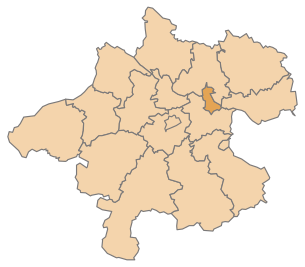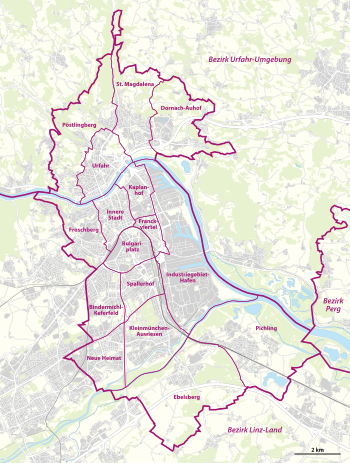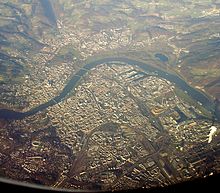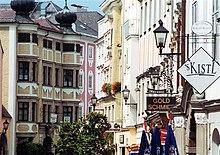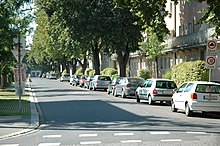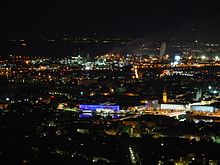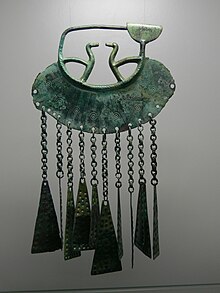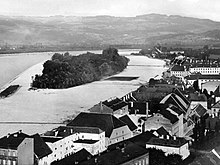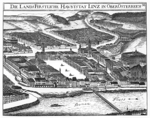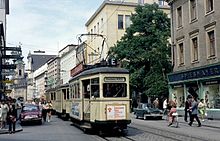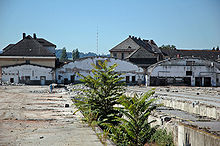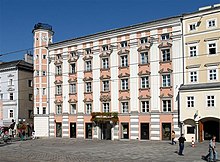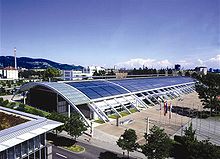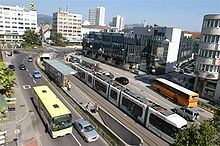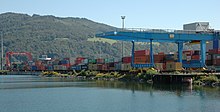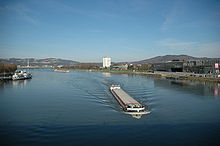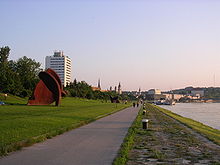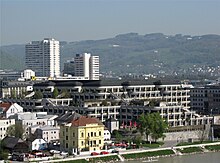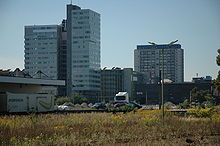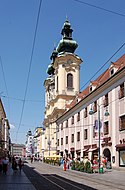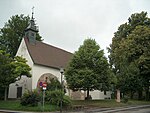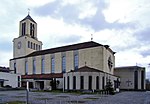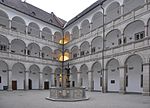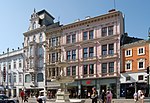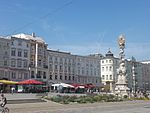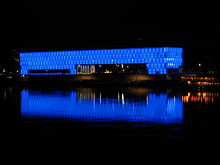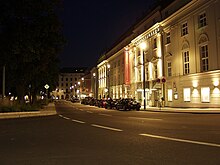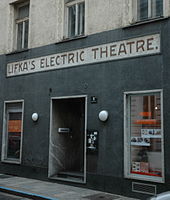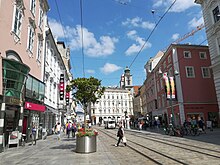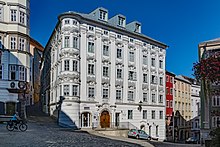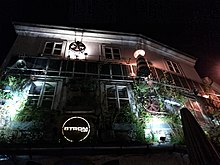Linz
|
Statutory city Linz
|
||
|---|---|---|
| coat of arms | Austria map | |
|
|
||
| Basic data | ||
| Country: | Austria | |
| State : | Upper Austria | |
| Political District : | Statutory city | |
| License plate : | L. | |
| Surface: | 95.99 km² | |
| Coordinates : | 48 ° 18 ' N , 14 ° 17' E | |
| Height : | 266 m above sea level A. | |
| Residents : | 206,595 (January 1, 2020) | |
| Postcodes : | 4010, 402x, 403x, 404x | |
| Area code : | 0732 | |
| Community code : | 4 01 01 | |
| UN / LOCODE | AT LNZ | |
| Address of the municipal administration: |
Hauptstrasse 1-5 4041 Linz |
|
| Website: | ||
| politics | ||
| Mayor : | Klaus Luger ( SPÖ ) | |
|
Municipal Council : (2015) (61 members) |
||
| Location of Linz | ||
 Linz, from the Franz-Josefs-Warte |
||
| Source: Municipal data from Statistics Austria | ||
Linz is the provincial capital of Upper Austria and with 206,595 inhabitants (as of January 1, 2020), after Vienna and Graz, the third largest city in Austria and the center of the country's second largest conurbation with 801,085 people (as of 2019) .
The city on the Danube has an area of 95.99 km² and is the center of the Upper Austrian central area . As a statutory city , it is both a municipality and a political district ; also the seat of the district authorities of the neighboring districts of Linz-Land and Urfahr-Umgebung .
After the end of the Second World War (1945) Linz had the reputation of a dusty steel city, which it owed to the largest employer, the steelworks of today's Voestalpine AG . But thanks to improved environmental protection and numerous cultural initiatives, for example events such as the Linzer Klangwolke , the Bruckner Festival, the Pflasterspektakel and the Prix Ars Electronica and the Ars Electronica Festival, the city gradually gained a new image. The Crossing Europe film festival has been held annually since 2004 . In 2013 the new Musiktheater am Volksgarten , a modern theater and opera house, was opened. With these and other initiatives, Linz was able to position itself as a city of culture, although some of the structures of the old industrial city are still visible. As a university city with several universities , Linz also has numerous courses in the arts and culture.
The city gives its name to the Linzer Torte , whose recipe is considered the oldest known cake recipe in the world.
The city is also unofficially referred to as Linz on the Danube in order not to be confused with the German city of Linz on the Rhine .
geography
Linz is located in eastern Upper Austria and stretches on both sides of the Danube . The north-south extension is 18.6 km, the east-west extension 12.3 km. The city is located in the Linz Basin and borders on the Kürnberger Forest and the fertile Eferdinger Basin in the west . North of the Danube, in the Urfahr district , Linz is bounded by the Pöstlingberg (539 m), the Lichtenberg (927 m) and the hills and mountains of the Mühlviertel . The eastern city limits are marked by the Danube, which first runs through the city in a northeast-southeast semicircle and then flows around it. The Traun flows into the Danube 7 km southeast of the city center and marks the inner-city border to the largest district of Ebelsberg . The Alpine foothills begin south of the city .
Of the approximately 96 km² urban area, 29.27% are grassland, 17.95% forest, 6.39% water, 11.63% are traffic areas and 34.76% are building land.
Neighboring communities
Linz borders in the north and east, consistently on the left of the Danube, on seven municipalities in the Urfahr-Umgebung (UU) district, in the south and west on five municipalities in the Linz-Land (LL) district, and in the southeast, in a short section also on the left the Danube, to a municipality in the district of Perg (PE).
The following tables provide an overview of the municipalities that border Linz directly in terms of political boundaries, and the municipalities that do not border Linz directly, but follow immediately afterwards, and which are also part of the Linz “ bacon belt ” due to the high commuter rates to the city . The district in which the respective municipality is located and the most recently surveyed population are also given.
The incorporation of some neighboring communities ( Greater Linz ) is occasionally discussed by politicians and the media. The reason for this is that Linz finances many supraregional projects from its budget, which also benefit the residents of the surrounding communities without these contributing financially. The boundaries between the urban area and the surrounding area are still politically present, but not recognizable in society or in the cityscape.
| local community | Bez. | Area in km² |
population | |||
|---|---|---|---|---|---|---|
| 1981 | 2001 | 2011 | 2020 | |||
| The following communities border directly on Linz | ||||||
| Leonding | LL | 24.03 | 19,389 | 22,203 | 25,295 | 28,929 |
| Traun | LL | 15.49 | 21,464 | 23,470 | 23,810 | 24,756 |
| Ansfelden | LL | 31.33 | 13,324 | 14,789 | 15,673 | 17.092 |
| Engerwitzdorf | UU | 40.98 | 5,258 | 7,516 | 8,416 | 8,840 |
| Branches | LL | 8.48 | 3,431 | 6,025 | 6.230 | 6,718 |
| Saint Florian | LL | 44.12 | 4.129 | 5,530 | 5,913 | 6.181 |
| Steyregg | UU | 32.96 | 4,394 | 4,749 | 4,764 | 4,932 |
| Gramastetten | UU | 40.23 | 3,663 | 4,525 | 4,677 | 5.114 |
| Puchenau | UU | 8.18 | 3,368 | 4,674 | 4,426 | 4,477 |
| Altenberg | UU | 36.32 | 2,853 | 4,075 | 4,334 | 4,672 |
| Luftenberg on the Danube | PE | 16.86 | 3,079 | 3,665 | 3,867 | 4,279 |
| Lichtenberg | UU | 18.59 | 1,554 | 2,389 | 2,606 | 2,728 |
| Kirchschlag | UU | 16.78 | 1,378 | 1,903 | 2,009 | 2,201 |
| Other communities within a radius of around 10 km | ||||||
| Pasching | LL | 12.47 | 6.325 | 6.123 | 6,584 | 7,629 |
| Gallneukirchen | UU | 5.19 | 4,398 | 6,183 | 6,306 | 6,567 |
| Wilhering | LL | 29.99 | 4,108 | 5,191 | 5,778 | 6,209 |
| Hörsching | LL | 29.99 | 4,683 | 5,233 | 5,780 | 5,919 |
| Ottensheim | UU | 11.73 | 3,579 | 4,312 | 4,503 | 4,738 |
| St. Georgen an der Gusen | PE | 7.09 | 3,093 | 3,529 | 3,639 | 4,262 |
| local community | Bez. | Area in km² |
1981 | 2001 | 2011 | 2020 |
| population | ||||||
Linz agglomeration
The agglomeration (metropolitan area) describes the population of a core city , in this case, Linz, and the connected structurally directly to these settlements, without regard to politically defined limits. From this point of view, the Linz agglomeration comprises around 271,000 people. The official population of Linz and all 13 neighboring communities is larger at 289,107 people (2001), as not all settlements in the neighboring cities and communities are directly connected to Linz.
Another way to determine the importance of an urban region is the commuter rate. Since Linz has more than 154,867 jobs, but only 83,245 of the 188,118 inhabitants are employed, 89,294 people commute to Linz to work every day - 7,687 even from other federal states, mostly from nearby Lower Austria. In addition to the daily commuter volume, there are 18,525 Linzers who do not work in Linz, but mainly in the commercial and industrial areas to the south and south-west. With an average employment rate of 50% in the surrounding communities and 45% in the core city, around 367,000 people depend on the jobs in Linz. Including the tens of thousands of jobs, mainly in the southern suburbs, the Linz agglomeration has a population of around half a million, which is mainly located in the Upper Austrian central area and the traditionally structurally weaker hill country Mühlviertel north of Linz.
Of the 89,294 commuters to Linz, 24,593 (27.5%) come from Linz's 13 neighboring communities. In total, 41,489 commuters, that is around 46.5%, come from the four districts of the Mühlviertel and another 23,403 or 23.2% from the Linz-Land district . 21.7% come from the remaining districts of Upper Austria, mainly from the nearby districts of Eferding , Wels , Wels-Land , Steyr and Steyr-Land . The remaining 8.6% come from other federal states.
City structure
The city forms a single village . Since January 1, 2014 (decision of the city senate of September 2013) the city has been divided into 16 statistical districts:
| No. | Stat. district | Pop. | Area in ha |
|---|---|---|---|
| 1 | Inner city | 25,386 | 278.9 |
| 2 | Urfahr | 24,017 | 426.8 |
| 3 | Pöstlingberg | 4,619 | 858.1 |
| 4th | St. Magdalena | 11,990 | 655.3 |
| 5 | Dornach-Auhof | 7,298 | 682.6 |
| 6th | Kaplanhof | 9,914 | 243.2 |
| 7th | Franckviertel | 6,856 | 120.7 |
| 8th | Bulgarian place | 16,721 | 260.3 |
| 9 | Frog mountain | 11,733 | 452.8 |
| 10 | Bindermichl-Keferfeld | 20,303 | 412.0 |
| 11 | Spallerhof | 12,725 | 297.1 |
| 12 | New home | 13,823 | 413.2 |
| 13 | Kleinmünchen-Auwiesen | 22,386 | 645.1 |
| 14th | Industrial area port | 137 | 1,277.4 |
| 15th | Ebelsberg | 10,804 | 1,291.2 |
| 16 | Pichling | 8,183 | 1,290.0 |
| TOTAL | 206,895 | 9,604.7 | |
City structure until 2013
In 1957 Linz was divided into nine districts and 36 statistical districts . These in turn consisted of a total of 863 building blocks. A division of the urban area into urban districts as political units only exists in Austria in the cities of Vienna and Graz . When redefining the inner-city boundaries, the boundaries of the formerly incorporated communities were only taken into account to a limited extent. For example, all the suburbs south of the Traun were combined into a single district and, at the same time, a statistical district of Ebelsberg . The area of the former St. Peter was also significantly changed, to name just two examples. The city districts and statistical districts that existed until the end of 2013 cannot therefore be equated one-to-one with the dimensions of the former suburbs of Linz.
The largest statistical district in terms of both population and area was the aforementioned Ebelsberg in the south of the city with 25.81 km² and around 17,421 inhabitants. The second largest and at the same time the least populous district and statistical district was St. Peter . It had only 377 inhabitants on 9.13 km², but this was due to the fact that the area of the demolished, formerly independent municipality and the former district was almost exclusively an industrial area, of which voestalpine took up most of the space (industrial area since the beginning of 2014 -Port). The terms of area smallest statistical district was the 45.6 hectares large old quarter .
Cadastral communities
In a slightly different way, the city is divided into 14 cadastral communities according to the land register (area: as of December 31, 2018):
Incorporations
When the community system was introduced in Austria in 1848 , it was already planned that the Linz suburbs of Lustenau and Waldegg would be incorporated. However, since the two places wanted to remain independent and were even planning a merger, the incorporation could only take place in 1873 after an application by the Linz municipal council was granted to the state parliament. The city area of Linz grew from 6 km² to 20 km².
In 1906, when Linz had already become significantly more attractive, parts of the Leonding community , namely Gaumberg, Untergaumberg and Landwied, sought to be incorporated into Linz. However, the then municipality of Leonding made unacceptable demands, so that the negotiations failed. However, there was no resistance to the incorporation of St. Peter . As early as 1912 an agreement was reached with the municipal council of St. Peter. The incorporation came into force in 1915 and Linz grew to an area of 29 km². At the same time, after several failed attempts, negotiations with the city of Urfahr were well advanced, but they had to be postponed due to the outbreak of the First World War . After the end of the war, the negotiations continued, so that on May 31, 1919, the incorporation of Urfahr, including the previously independent municipality of Pöstlingberg , which had recently been attached to Urfahr, became legally effective. Linz now reached an area of 42 km².
In 1923, the industrial town of Kleinmünchen , which was then south of Linz and had an area of 13 km², was incorporated. In 1934 the urban area was rounded off with the cession of uninhabited areas on both sides of the Danube from Katzbach (Heilham) and Steyregg (Steyregg had until then, as a relic of the time before the Danube regulation, uninhabited grounds west of the Danube in today's harbor district) and grew by an area of 2 km² .
After Austria was " annexed " to Germany in 1938, the Ebelsberg community was incorporated into Linz. St. Magdalena was incorporated north of the Danube. The size of the city grew to 95 km² in 1938, and since the last slight expansion in 1939 ( Keferfeld von Leonding) the size of the city is 96 km².

The division of the city districts and districts, which was valid until the end of 2013, goes back to a resolution from 1957. This put an end to the division of the city into its incorporated communities. The city was divided into nine districts, some of which brought together several incorporated municipalities or expanded their former borders to include newly determined statistical districts. Within these districts, a total of 36 districts were created, which, as far as possible, were based on former cadastral communities or existing or expected closed settlements. Traffic routes also served to define the boundaries. For example, Landstrasse, Wiener Strasse and the city motorway served as borders for numerous statistical districts. When naming the new city districts, the name of the settlement area that is common among the population was mostly chosen. With the reorganization of January 1, 2014, this classification was abandoned and 16 new statistical districts were set up instead. Numerous old statistical districts were merged, such as the port district and St. Peter in the industrial area-port district. Ebelsberg, the largest district to date, has been divided. In the east it is now bordered by the newly created Pichling district.
climate
The climate around Linz is both suboceanic and subcontinental. The long-term monthly mean temperature fluctuates between −0.4 ° C in January and 19.9 ° C in July. The average amount of precipitation is around 60 mm in the months of September to April and increases up to around 95 mm in the summer months of June, July and August. The annual amount of precipitation averages around 870 mm.
The long-term mean annual temperature (determined in the years 1981–2010) is 9.9 ° C.
| Linz | ||||||||||||||||||||||||||||||||||||||||||||||||
|---|---|---|---|---|---|---|---|---|---|---|---|---|---|---|---|---|---|---|---|---|---|---|---|---|---|---|---|---|---|---|---|---|---|---|---|---|---|---|---|---|---|---|---|---|---|---|---|---|
| Climate diagram | ||||||||||||||||||||||||||||||||||||||||||||||||
| ||||||||||||||||||||||||||||||||||||||||||||||||
|
Average monthly temperatures and rainfall for Linz
|
||||||||||||||||||||||||||||||||||||||||||||||||||||||||||||||||||||||||||||||||||||||||||||||||||||||||||||||||||||||||
Ecology and environment

Since the mid- 1980s , Linz has shed its previously problematic environmental image as an industrial location through an extremely consistent policy in this regard . The emission of the air pollutants sulfur dioxide (SO 2 ), fine dust and nitrogen dioxide (NO 2 ) was reduced from around 47,000 tons in 1985 to around 14,000 tons in 2003. The greatest decline was in sulfur dioxide, around 80% of which was achieved by voestalpine , which is still the city's largest industrial company. However, the decline from 18,000 tons in 1985 to 4,000 tons in 2003 was not only due to voestalpine.
While private households once caused almost 1,000 tons of SO 2 emissions, this value has practically disappeared from the statistics today. Heating plants and the chemical industry, which once caused around 2,000 tons of SO 2 emissions, reduced their emissions to less than 100 tons by 2003. Up until 2002 the value only increased slightly for motor vehicle traffic, but after around 250 tonnes in 2002, a year later it even caused a little less than the chemical industry plus heating plants. The remaining emissions are caused on the one hand by voestalpine, namely around 3,700 tons, and on the other hand by other industrial and commercial enterprises with around 200 tons, instead of 750 in 1985.
Around 60% of NO 2 emissions were once attributable to the city's chemical plants, but they reduced their emissions from just under 10,000 tons in 1985 to around 800 tons in 2003. After NO 2 emissions from motor vehicle traffic to almost 2,000 halved, the main culprit is now voestalpine, which was only able to reduce NO 2 emissions by 1,000 tons to 3,000 in the same period. Dust emissions, for which voestalpine was responsible for 80% in 1985, reduced them from 8,000 to 1,500 tons by 2003. Motor vehicle traffic is the only area in which increases in dust pollution can be observed. In 2006, fine particulate matter had exceeded the statutory maximum values at all measuring stations in the city.
The increase in CO 2 emissions from 7.7 million tons in 1988 to 10.4 million tons in 2007 can be attributed to the heating plants, the chemical industry and, above all, to voestalpine, which continued until 1993, the year with the lowest total value, was still responsible for the decrease in emissions to a total of 6.8 million tons, but then emitted more CO 2 again . However, other commercial enterprises, private households and motor vehicle traffic were able to reduce these emissions somewhat across the board.
In the years 2007 to 2011, there were only minor changes in the pollution level in Linz. Linz is not in an extreme position in the international air quality comparison. Only sulfur dioxide (SO 2 ) was slightly above average in an international comparison and in comparison with the other state capitals in the years 2007 to 2011. The stress tendency in Linz, however, is constant. For nitrogen dioxide (NO 2 ) and CO 2, however, Linz was rated better than the average.
From 2008, the air quality comparison was supplemented by the fine dust fraction PM 2.5 . These particles have a significant impact on human health. This could be measured in Linz in 2011 with 19 μg / m³. For a more transparent comparison of the measuring point density, the population and the size of the immission area were also included.
In Linz, the annual mean value with a population density of 189,845 and an immission area of 96 km² is 4 μg / m³ sulfur dioxide (SO 2 ), the NO 2 emissions are 32 μg / m³ and the CO values are 360 μg / m³. The fine dust pollution (PM 10 ) is 18 μg / m³. When the PM 10 daily mean value of 50 μg / m³ is exceeded, Linz is in the midfield for 45 days. Compared to 2001, the number of days has been significantly reduced from 62 to 45. Linz achieved the lowest value in 2009 with 30 days.
The immissions to the Linz environment also decreased to the same extent as the emissions . Only the ozone values stagnate at a high level and vary slightly depending on the summer. Nevertheless, Linz has been able to improve further in terms of air pollution compared to the state capitals in recent years and is now on par with Vienna in first place.
In 2006, the city of Linz won the title of “ Austria's most nature- friendly municipality” in an Austria-wide competition organized by the Austrian Nature Conservation Union. Above all, the achievements of the city of Linz in the field of species protection (e.g. nest box campaigns on buildings), stream renaturation (a total of 9 km of regulated streams were renatured) and funding for ecologically oriented landscape management by city farmers were honored. The natural history station of the city of Linz is responsible for nature conservation and urban ecology , which together with the botanical garden belongs to the Linz city gardens. The station publishes the quarterly journal ÖKO.L .
Focus
The center of the city of Linz is in the cadastral community of St. Peter, Aigengutstrasse 20, on a property owned by ÖBB-Postbus GmbH. This point represents the geometric center of gravity of a flat surface (= center of gravity).
Specifically, the center of the city of Linz is at the following coordinates:
N48 ° 17'03.6 "E014 ° 18'58.1" (WGS84)
5.348.128 449.269 (UTM 33N)
history
prehistory
Around 400 BC Several Celtic fortifications and settlements emerged within today's urban area and in the immediate vicinity, along the Danube. The Oppidum von Gründberg , in the area of today's Urfahr, to the west of the Haselgraben, and the Freinberg, west of the city center, were located within today's city limits , as impressive Celtic ramparts.
The settlement on the Freinberg probably already bore the Celtic name Lentos, which means something like flexible or curved. The name was subsequently transferred to the later Roman fort. The fortress probably fell to Rome with the largely peaceful integration of the Kingdom of Noricum .
Antiquity
Linz was mentioned for the first time as "Lentia" in the Roman state manual Notitia dignitatum . To secure the connection over the Danube, the Romans built a wood-earth fort in the middle of the 1st century , which was replaced by a larger stone fort in the 2nd century. Lentia was destroyed several times after the 2nd century by invasions of the Germanic peoples (e.g. between 166 and 180 during the Marcomannic Wars ), but survived the storms of the migrations and thus has a settlement continuity through late antiquity.
middle Ages
In the early Middle Ages, Linz became more important again with the advance of the Bavarian duchy to the east. In 799 the German name of the city was mentioned for the first time as "Linze". In the Raffelstetten customs regulations (between 902 and 906) Linz is mentioned for the first time as a royal market and customs place. During the rule of the Carolingians , Linz fulfilled market and customs duties for the Traungau. Until 1210 Linz was under the Bavarian dukes.
Under the Babenbergs , Linz developed into a city that was laid out according to plan in 1207, including the old settlement core. In 1230 the new main square was created. By 1240 Linz received a city judge and a city seal. The Linz toll was one of the most important sources of income for the Austrian dukes, which gave the city an upswing. It was also an interesting place for meetings of princes due to its peripheral location to Bavaria. In 1335, the acquisition of Carinthia by the Habsburgs was completed there.
Linz had been the seat of the governor since the end of the 13th century and thus became the central location of Austria above the Enns . Friedrich III. even chose the city as a residential city and made it the center of the Holy Roman Empire from 1489 to 1493 after Matthias Corvinus had conquered Vienna. This as well as the court of Duke Albrecht VI, which was located in Linz from 1458 to 1462 . brought the city on the one hand a cultural and political increase in importance, but at the same time the demands of the court were a burden on the city.
The first Upper Austrian Landtag was held in Enns in 1408. Other early state parliaments took place in Enns and Wels. The first state parliament in Linz took place in 1457 at the Linz Castle. In 1490 Linz was first designated as the state capital and the city council was given the right to elect a mayor and a city judge. On March 3, 1497, Linz received the right to build a bridge over the Danube from the Roman-German King and later Emperor Maximilian I. It was only the third Danube bridge in Austria after Vienna and Krems.
Modern times
At the time of the Reformation , Linz was Protestant until 1600. At times there was also a radical Reformation Anabaptist congregation in Linz under the reformer Wolfgang Brandhuber . During the Protestant period, the estates built the country house on the site of the former Minorite monastery in the Renaissance style as a symbol of their power. The landscape school, where Johannes Kepler taught between 1612 and 1626, was later housed in the country house . From 1600 Jesuits and Capuchins carried out the Counter-Reformation . The resulting Upper Austrian Peasants' War also hit the city in 1626 when it was besieged for nine weeks under the leadership of Stefan Fadinger .
At the time of the Counter Reformation, the Jesuit Georg Scherer worked here as a fiery preacher against the Reformation, who was struck by a blow in the pulpit in a sermon on the persecution of witches in the church in 1605 and died.
After the end of the Thirty Years War , the city was redesigned in baroque style. The founding of new monasteries by orders played a major role in this. In 1672 Christian Sint founded the " woolen factory ", the first textile factory in Austria. In the 18th century this was nationalized; at times over 50,000 people worked there.
During the Austrian War of Succession , Linz was occupied by Bavarian and French troops in 1741. On May 3, 1809, during the coalition wars at the crossing of the Traun, there was a bloody battle near Ebelsberg between the Austrians and the French, which gave the impetus for the construction of a fortification , which was realized from 1830.
In 1761, the woolen manufacture (on the banks of the Danube, demolished in the 1960s) was the first textile factory in Austria; spinning and weaving was still outsourced to homework.
On the Assumption Day , on August 15, 1800, a major fire broke out that severely damaged the castle, the country house and the old town. As a result, the moat and ramparts were leveled.
During the March Revolution of 1848, Linz was spared the kind of fighting that raged in Vienna. On March 15, the freedom of the press and the lifting of censorship were celebrated, which Emperor Ferdinand had decreed the day before in Vienna under public pressure. At the same time he allowed the arming of the bourgeoisie with an imperial patent. Therefore, on 16 March, a National Guard was founded in Linz, attached to the old tradition of vigilante anknüpfte and the maintenance of public order and the protection saw obligation of property. The first commandant of the Guard, which during its three-year existence until the National Guard was banned in 1851, never had more than 1,600 members, was Count Johann von Weißenwolff . Parallel to the Vienna Academic Legion , the student corps was founded in the course of the revolution in Linz , but it was still affiliated to the National Guard in 1848. After March 15, 1848, a citizens' committee was formed which was organized on the basis of the Pillersdorf constitution and scheduled the first mayoral elections for June. The winner was the democrat Reinhold Körner , who replaced Joseph Bischoff , who had been ruling for 27 years , and became provisional mayor.
In 1850 a provisional municipal code came into force, on the basis of which the first municipal council elections were held. Although only six percent of the population, mainly the educated and property classes and other better-off people, were allowed to vote due to various restrictions, Reinhold Körner won again. However, after the New Year's Eve patent of 1851, which ushered in the phase of neo-absolutism , democrats and the liberal bourgeoisie were quickly pushed back from political life. As the first prominent democratically minded politician, Karl Wiser was forced to resign from his political offices. Reinhold Körner followed him in 1854. Thereafter, Linz was ruled by provisionally appointed mayors until 1861. In the municipal council elections of 1861, however, the Democrats were able to assert themselves again. Reinhold Körner started his second term.
Steam shipping was introduced on the Danube from the middle of the 19th century . The horse-drawn railway , built from Budweis in 1832 , was the first railway on the continent. Until 1861 the city became an important junction on the way from Vienna to Salzburg or Passau through the Westbahn (" Kaiserin Elisabeth-Bahn "). In 1880 a horse-drawn tram was built in Linz . This was electrified in 1897. The Pöstlingbergbahn , the steepest adhesion railway in the world, was opened in 1898.
From the middle of the 19th century, industrialization also affected Linz. In 1840 Ignaz Mayer founded the first large metal processing company in the city with the Linz shipyard, and the German locomotive manufacturer Krauss set up a branch in Linz in 1879 due to high import duties. The textile industry also had an important location in Linz.
The 8th German Fire Brigade Day took place in Linz from July 6th to 8th, 1870 .
From 1892 the factory arm of the Danube was filled in, this was created in 1572 during a flood together with the Straßerinsel (also Straßerau or soldiersau ). The name Fabriksarm goes back to the local woolen factory. When the river was regulated, the island also disappeared. This was first called Au , later, after the barracks buildings, soldiersau and finally after an owner, Straßerau or Straßerinsel.
Numerous former suburbs were incorporated by 1923, including Urfahr on the northern bank of the Danube in 1919 .
- Views
View around 1674. Copper engraving from the Topographia Austriae superioris modernae
City view (around 1694), Floriani altar of the parish church
First republic
After the end of the First World War and the proclamation of the republic, there was a revolutionary atmosphere in Linz - as in many other places - which was also expressed in demonstrations and looting. In February 1919 and May 1920, martial law was imposed in the city after violent riots.
In contrast to the province of Upper Austria , where the Christian Social Party had an absolute majority in both the republic and the monarchy, the first municipal council election in the city of Linz in 1919 based on universal and equal suffrage brought about a political upheaval: the two-thirds majority of the German nationals became an absolute one Majority of the Social Democratic Workers' Party in Austria .
During the democratic phase of the First Republic , Linz developed into a big city: through immigration and incorporation, the population of 100,000 was exceeded in 1923. When it was united with the city of Urfahr in 1919 , the urban area of Linz also expanded north of the Danube. This meant that the infrastructure had to be enlarged under the most difficult economic conditions: social welfare was expanded to include new parent counseling centers, kindergartens and increased youth welfare, and the municipal farmyard was expanded to become a central company for garbage collection and transport as well as a material procurement center. The focus was also on urban housing, but the extremely large housing shortage could not be resolved. Despite the willingness to work together, the fundamental differences between the political parties emerged here: the bourgeois parties wanted to promote residential construction and rejected the larger residential buildings as "interest barracks". They saw urban enterprises as undesirable competition for the private sector, while the Social Democrats insisted on urban enterprises to fight unemployment and as price regulators.
During the First Republic, the commitment to democracy and the willingness to work together united Christian Socialists, Social Democrats and Greater Germans in Linz despite the different ideologies and views until 1933. After that, internal and foreign policy developments in Linz also disrupted cooperation on factual issues.
February fighting 1934
As a result of the escalating conflict between the ideological camps in the First Republic and the anti-democratic course of the Federal Government under Engelbert Dollfuss is Austrian Civil War to be seen. It started in Linz with a search for weapons in the party headquarters of the Social Democratic Workers' Party . This was preceded by a letter from the Linzer Schutzbund leader Richard Bernaschek and other functionaries to the party executive in Vienna on February 11, 1934. Here resistance was announced in the event of further arrests of Schutzbund or weapon hunters. The letter arrived in Vienna late in the evening. Otto Bauer gave instructions by telephone not to do anything without the consent of the party leadership. However, the phone call was tapped. So the police knew of Bernaschek's will to resist when they started looking for weapons in the Hotel Schiff , the social democratic party headquarters on Landstrasse, at around 7 a.m. on February 12 . Even before his arrest, Bernaschek alerted the Republican Protection Association and gave the signal for an uprising. The Schutzbund crew in the Hotel Schiff fought with the intruding executive and the armed forces called for help until noon. Further centers of the fighting in Linz were the Eisenhandkreuzung, the Diesterwegschule, the village hall, the Parkbad and the railway bridge, in Urfahr the Spatzenbauer and on the Freinberg the Jägermayrhof . A particularly momentous incident occurred at Polygonplatz (today Bulgariplatz): A taxi with four members of the armed forces drove towards the position of the Schutzbund, in the subsequent firefight, under circumstances that have not yet been fully clarified, three soldiers were killed. A court martial passed three death sentences against the Schutzbündler involved, with the one against the working-class Samaritan Anton Bulgari being carried out on February 22nd.
At dawn on February 13, the Schutzbund gave up the last remaining road blockades and occupations in Linz. The fighting in Linz had killed at least 27 people: four civilians, eight members of the Schutzbund and 15 dead on the part of the executive. On the part of the Schutzbund, however, the injured and dead were kept secret for fear of reprisals by the authorities, so that precise information about the wounded and killed is not possible.
Corporate state
On February 12, 1934, the Social Democratic Party was banned and its support organizations were smashed. A government commissioner was appointed in Linz and, from November 1934, a community day was primarily made up of Christian socialists and home guard representatives. There was a radical change in personnel in the city administration, some of the municipal companies had to limit their activities or were sold. The corporate state also tried to anchor itself symbolically: streets were renamed and monuments were erected for those who died on February 12, 1934 on the government side. The cult of Federal Chancellor Dollfuss, who was killed in a National Socialist coup attempt on July 25, 1934, also met with a response in Linz, including the renaming of the Diesterweg School to “Dollfuss School”. In addition, cultural life should be redesigned according to ideological positions.
Connection and time of National Socialism

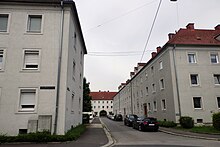
When the German troops marched in on March 12, 1938, Adolf Hitler embarked on a “triumphal journey” from his native Braunau to Vienna and spoke in Linz for the first time as Chancellor of Austria on Austrian soil. It was only here that, in view of the jubilation in the population and the reluctant reactions from abroad, he decided to immediately and completely complete the annexation of Austria to the German Empire. Due to his emotional connection to Linz, Hitler took over the “sponsorship” of Linz (which also became one of the five Führer cities ) and promised investments by the Reich.
On March 13, 1938, Hitler signed the Anschluss law in the Hotel Weinzinger .
Hitler, who had attended school in Linz, intended to spend his retirement here one day. That is why he intended the city to play a prominent economic and cultural role in the empire. The expansion plans included a boulevard with magnificent buildings such as the opera, theater and galleries, but especially the “Führermuseum”, which was to house the world's largest art and picture gallery. For this collection, works of art were stolen from museums in the occupied and conquered countries as part of the “ Linz special order ” (see also: Architecture under National Socialism ). In addition, Linz was to be developed into an industrial and administrative center with representative buildings for the National Socialist German Workers' Party (NSDAP) and its sub-organizations and oversized administrative buildings. This would have meant extensive razing of the historical building stock on both the Linz and Urfahr side. With a few exceptions such as the Nibelungen Bridge , the bridgehead buildings and today's Heinrich-Gleißner-Haus , the plans pushed by Albert Speer were not implemented.
In the expansion of the existing industry, the restructuring to large companies in the metallurgical and chemical sectors should be mentioned. With the 1938 built in the era of National Socialism steel and armaments factory Reichswerke AG for ore mining and ironworks "Hermann Goering" Linz and the nitrogen works Ostmark the foundation for the later was VÖEST and all their successors, and set for the Linz chemical industry. The residents of St. Peter-Zizlau were resettled and the buildings demolished for the construction of the factory premises and the construction of the port that was also planned there .
1941–1943 the railway line to Gusen, including a bridge over the Danube, is built next to the two large industrial companies over to Steyregg as a junction from the Western Railway. There were several concentration camps in Gusen, with the underground production of large parts of Messerschmitt aircraft. Evidence from 2019 also speaks for the construction of the V2 rocket and for research on nuclear fission.
In addition to prisoners of war and foreign workers, prisoners from the Mauthausen concentration camp were also deployed in the industrial companies mentioned .
Due to the expansion of industry, the associated resettlement and the influx of workers, the already existing housing shortage worsened. As a remedy, entire districts such as the Bindermichl or the “Neue Heimat” were built with large residential complexes that still shape the appearance of these districts today. The expansion of the necessary infrastructure (schools, kindergartens) did not take place. With the simultaneous incorporations, the urban area was almost doubled and reached the extent that it still exists today.
Linz was also a center of persecution: over 100,000 people from all over Europe were killed in the nearby Mauthausen concentration camp and its subcamps. In total, there were three satellite camps of the Mauthausen concentration camp and 77 camps for forced laborers in the city of Linz. The 600 Jews had to leave Linz - 150 of them were murdered by the National Socialists. Hundreds of victims of Nazi euthanasia were in the Niedernhart sanatorium and nursing home in Linz, today's state mental hospital Wagner-Jauregg , or were transferred from there to the Nazi euthanasia center at Hartheim Castle near Linz.
Ultimately, those who had served the regime out of enthusiasm or out of forced loyalty also suffered from the consequences of National Socialist policies. In Linz, for propaganda reasons, the construction of air raid shelters for the population was not forced until the end of 1943. In November 1944, entire districts were still without safe cover during air raids. Over 1,600 people died in the 22 bomb attacks on Linz between July 1944 and April 1945, and thousands of Linzers lost their lives as members of the German Wehrmacht .
In Linz, tanks were built in the Göring works and submarines in the area of the port .
On May 4 and 5, 1945, the city was under American artillery fire and Gauleiter August Eigruber set off into southern Upper Austria. The original plan to defend the city by urban warfare was abandoned. On May 5th at 11:07 a.m. the first American tanks arrived in the main square.
post war period

From 1945 until the end of the occupation in 1955, Linz was divided along the Danube. The north (Urfahr) was occupied by the Soviets , the south (Linz) by the Americans .
In 1966 Linz became a university town with the "University for Social and Economic Sciences", from which in 1975 the Johannes Kepler University Linz emerged . From 1971 to 1991 Linz reached its highest population level (see section Population ). By the end of the 1970s, many residential buildings were built that are now referred to as the “building sins” of the time. Within a few years, the simplest high-rise buildings were built in many parts of the city to meet the enormous demand for housing. In this environment, projects such as the Lentia 2000 and other residential complexes were created.
From the end of the 1970s, Linz tried to get away from the “steel city” image of the gray and dirty industrial city . Environmental measures and requirements for industrial companies to improve air quality were taken (see section Ecology), which made Linz one of the cleanest cities in Austria to this day. At the same time, new cultural institutions were founded. In 1974 the Brucknerhaus was opened on the Donaulände, in 1978 the Anton Bruckner Institute Linz (ABIL). In 1979 the city council launched the Ars Electronica , a festival for computer art. This festival is now one of the most important and significant of its kind. Thanks to the Ars Electronica Center and the municipal Lentos Art Museum for Modern Art (opened in 2003), Linz also became important as a city of culture. The European Union recognized this importance by being elected European Capital of Culture in 2009. It was decided in 2004 to build a new music theater at the Blumauer Kreuzung site, near the main train station and adjacent to the Volksgarten .
With the increasing prosperity in post-war Austria, the desire of many families for a “house in the country” increased. This had serious consequences for Linz in the 1990s. Although there were around 12,000 people looking for accommodation in 1990, Linz lost around 20,000 residents to the surrounding communities in just ten years, as there was no suitable housing offer in the city. Since then, Linz has been trying to improve its appearance and attractiveness, with the support of the Province of Upper Austria. This is done on the one hand through infrastructure projects, such as the new construction of the main train station including the development of the surrounding area into an office district with high-rise buildings from ÖBB , Energie AG and the city's own knowledge tower , where the adult education center and the city library have been housed since 2007 . Furthermore, the tram network was expanded to the south and the bus and tram fleet is continuously being renewed. Measures to improve the quality of life were the underground installation of the city motorway at Bindermichl as well as the construction of the general hospital, the accident hospital and the Wagner-Jauregg-Landesnervenklinik. Direct measures to increase the number of inhabitants are increased residential construction. Several large residential projects have been realized since the late 1990s: Solar City Pichling, Lenaupark and development of the urban area in the south. The 1,300 apartments in Solar City, built between 1999 and 2005, are not only considered a pioneering project for social housing in the 21st century, but also an example of ecologically well thought-out construction.
In 2007, the construction of 1,700 apartments began. Most of them will be built on the site of the former women's clinic (415 apartments), while 200 residential units will be built at the Winterhafen. The south of the city is also being expanded, for example with the housing project at the former Laskahof civil engineering depot and the Traunausiedlung in Kleinmünchen. Construction of a new district on the site of the former freight station began at the end of 2013. Since the last census up to 2006, 5,000 inhabitants have already been regained or gained.
Coming to terms with the Nazi past
The municipal council of the city of Linz decided on September 19, 1996 to have the time of National Socialism including the period before 1938 and the denazification after 1945 scientifically processed by the city archive. Linz was the first city in Austria to deal intensively with its own National Socialist past. At the final presentation in May 2001, reference could be made to seven scientific publications, internet presentations and numerous lectures as the result of the project.
The culture of remembrance is also manifested in the erection of monuments and plaques for victims of National Socialism. Since 1988 in particular, numerous places of remembrance have been created in public space. Street renaming or street renaming also reflects the confrontation with the Nazi past: while 39 streets in Linz were renamed in 1945, immediately after the end of the Nazi dictatorship, there were only two between 1946 and 1987. Since 1988, however, 17 new traffic areas have been named after victims of National Socialism or after resistance fighters. In the recent past, several Nazi victims and activists against National Socialism received high awards from the city of Linz, such as Simon Wiesenthal , who founded his first Jewish documentation center in Linz after 1945.
population
Overview
In the 1971 census, Linz reached a peak of 204,889 inhabitants. While the post-war years, especially 1947, with around 3,750 births and 2,000 deaths, were characterized by enormous birth surpluses, the number of births halved from around 3,200 to 1,600 in 1979. However, there were birth deficits as early as 1970, where they had been up until then steadily increasing number of deaths (from 2,000 in 1947 to 2,500 in 1970) overtook the number of births. The deaths have since declined again, to around 1,900 in 2004, but the birth rate, which reached its low point in 1979, rose only irregularly and slowly after an interim high in 1993 (around 2,000 births) and an interim low in 1999 (almost 1,700 births) back to. While there were almost as few in 2001 as in 1999, the number has risen steadily since then, to 1,886 in 2005.
Linz is the only large city in Austria with 157,000 jobs, almost twice as many jobs as the city's population. This enormous surplus of jobs causes a correspondingly high rate of commuters from the surrounding communities of Linz, which causes enormous traffic problems in the city. According to the Eurostat survey from 2016, around 781,833 people live in the metropolitan area, the metropolitan region of Linz .
There are also large industrial areas south of Linz. Several shopping centers (such as UNO Shopping , PlusCity or the Infra Center ) in Linz and the neighboring communities lead to additional commuter traffic and exacerbate the traffic problem outside the city, around these industrial areas.
More than other Austrian cities, Linz also experienced large population losses in the last decades, especially between 1991 and 2001, due to the relocation of families to the surrounding communities. Due to good transport connections, such as the already several times expanded West Autobahn A 1 and Mühlkreis Autobahn A 7 as well as the Linzer Lokalbahn (LILO), the Mühlkreisbahn , the Pyhrnbahn and the Summerauer Bahn , which enable a quick connection to Linz even over longer distances, was made this tendency to emigration intensified. A counter-movement, such as that which has led to strong population increases in Vienna, Graz or Salzburg since 2001, could hardly be observed in Linz. This only started in 2012. Towards the end of 2015, the 200,000 mark was exceeded again.
religion
According to the 2001 census, religious affiliation is distributed as follows:
- 60.9% Roman Catholic
- 21.6% non-denominational
- 6.7% Islamic
- 4.4% Protestant
- 2.5% Christian Orthodox
- 3.9% other religions
From 1867 (religious patent) to 1938 there was a small Jewish community in Linz after immigration from the Nuremberg , Bohemia and Moravia area, which in the 1920s had almost 1,000 members - the majority of them lived in the Urfahr district . In 1877 the young community built the Linz synagogue . Already at the beginning of the 1930s, in view of growing anti-Semitism, emigration began. From the Anschluss in 1938, organized expulsions and murder began and Jewish property was Aryanized . The synagogue was destroyed during the Reichspogromnacht in 1938. A new synagogue was opened on the property in 1968. Today the Jewish community in Linz has fewer than 100 members.
The Christian sacred buildings include the New Cathedral , the Old Cathedral , the parish church , the pilgrimage basilica Pöstlingberg and the particularly old Martinskirche .
Important Roman Catholic institutions in the city are the Catholic-Theological Private University Linz and the bishop's seat of the Diocese of Linz .
There are several Roman Catholic and Evangelical Lutheran (AB) parishes in Linz . There is also an Evangelical Reformed (HB) and an Old Catholic congregation. Free churches and other communities are the Baptists , the Evangelicals , the Mennonites , the Methodists , the Adventists or the New Apostolic Church .
The Islamic religious community is working on the realization of a cultural center in the south of the city, which, in addition to a prayer room, will also accommodate Islamic associations, social and cultural institutions.
Serbian emigrants founded the Serbian Orthodox Church in Linz .
politics
The first municipal council elections in Linz, as in the rest of Austria, could only be held after the March Revolution of 1848. Until the 20th century, the right to vote was reserved for a small, wealthy part of the population. Local council elections were scheduled every three years. The councilors elected in this way then elected the mayor in turn. From 1875, a vice mayor was also appointed.
In 1867, on the occasion of the Austro-Hungarian settlement , the basic rights of citizens were laid down for the first time and an association law was passed, which subsequently enabled the establishment of political parties. The Catholic Volksverein was founded in 1848, but only became politically active in 1869/70 under the leadership of Bishop Franz Josef Rudigier of Linz . The Volksverein was set up as a mass party and soon had many members across Upper Austria. In 1884, the association achieved a majority in the state parliament for the first time, while within the city of Linz it was far removed from it.
The liberal-political association founded and led by Karl Wiser in 1869 was more successful. The supporters of the revolution of 1848 became fewer and fewer as younger generations held different views. This led to the liberal party becoming increasingly nationalistic, so that the party was renamed the German Association in 1885 . In 1888 Carl Beurle founded the German National Association for Upper Austria and Salzburg , which was soon also represented on the Linz municipal council. The two parties merged in 1897 to form the German People's Association.
The workers were only able to organize themselves into parties towards the end of the 19th century, as the political goings-on were monitored by imperial authorities. Workers' associations were established as early as 1868, but these were officially dissolved in 1877. In an effort to attract the workers towards the end of the 19th century, a Christian workers' association was founded, which was united with the Christian Social Party in 1907 . In 1891, the state party organization of the Social Democrats was founded in Linz, with Anton Weiguny playing a key role . A dense network of grassroots organizations was formed and with the expansion of the electoral law after the turn of the century, the Social Democrats rose to become a mass party in Linz as well. In 1905 he moved into the municipal council for the first time.
City Senate
In the city senate represented parties with their number of deputies:
- 3 SPÖ
- 2 FPÖ
- 2 ÖVP
- 1 The Greens
City council and mayor
Until 1877, the Linz municipal council was strongly influenced by liberals, supporters of the revolution of 1848. Thereafter, conservative parties gained increasing influence. Until 1900, however, the mayors continued to be appointed by the Liberals, who from 1885 onwards became a nationally conscious German association in the entire German-speaking part of the monarchy due to the emerging change of attitude . In 1900, Gustav Eder , a German national mayor, was elected for the first time. His successor Franz Dinghofer , who ruled from 1907 to 1918, also belonged to the German national party, which was more strongly represented in Linz than anywhere else.
Klaus Luger , SPÖ , has been mayor of Linz since 2013 . The three Vice Mayors of Linz were Detlef Wimmer (FPÖ) and Bernhard Baier (ÖVP) from 2015 and Karin Hörzing (SPÖ) since 2017 . On March 7, 2019, Wimmer resigned from the Linz city government, and was succeeded by the previous city councilor Markus Hein as Vice Mayor . Michael Raml became the new city councilor .
- For previous mayors see the list of mayors of Linz .
In the council due to the elections of September 2015 represented parties :
Town twinning
The following cities have signed partnership agreements with the city of Linz:
|
|
The following cities are also considered friendship cities:
City arms
Coat of arms history
The city arms developed from the seal image. The use of a city seal has been proven since 1242 by the announcement text "cum appositione sigilli civium in Linzhae" in a Wilheringer document dated March 1st. - The seal with the inscription
- + SIGILLVM. CIVIVM. IN . LINTZ
A document dated October 14, 1272 already shows the double-towered, crenellated, open city gate on rocky ground (Fünfberg). - In the early Gothic seal with the inscription
- + S. VNIVERSORVM. CIVIVM. IN . LINTZ
from an arbitration ruling by the Linz Council dated January 28, 1288, the naturally shaped towers and the gate structure now standing on the undulating water are roofed; The inclusion of the Austrian (red-white-red) binding shield in the city seal is significant under constitutional law .
In the privilege of March 10, 1490, Emperor Friedrich III. the “main act of our principality Austria ob der Enns” with expanded city freedom also the privilege of sealing in red wax. - The first colored document of the city arms from 1503 can be found as a watercolor pen drawing in the Rieder Sebastian Brotherhood Book.
As a result of the absolutist unitary state of Austria under Emperor Joseph II, it appears - in use from August 2, 1785 - in the
- . SIGILLUM. CIVITATIS. LINCENSIS.
The city's coat of arms is subordinate to the city administration, which has now become a state magistrate authority, as the breastplate of the crowned imperial double-headed eagle that dominates the field of seals, holding sword and scepter.
In the 19th century, the “artistic” representations of the coat of arms changed from indiscriminate imitation and mixing of older styles to often overloaded, poorly shaped images. - The version of the city arms proposed by Franz Lehrer and Max Kislinger, which was recognized by the Linz city council at its meeting on April 22, 1926 as the "correct execution", remained in force until 1935. - With the description in the Linz “Stadtrecht 1935”, the city coat of arms, freed from arbitrary ingredients from earlier decades, was anchored in law for the first time. In 1936, based on an ideas competition, its representation was officially determined based on the design by Franz Lehrer selected by a jury.
The new coat of arms is a simplification of the city coat of arms, which is perceived as too rich in color and shape, through a public competition organized by the city administration in 1962/63. The state law stipulation in the new city statute 1965 with simultaneous fixation of the city colors "red and white" was fixed to distinguish it from the white-red color combination used by the state of Upper Austria.
Gate and towers are the characteristic of the medieval fortified city. The expansion of the settlement, initially limited to the mountain, down to the Danube was emphasized by the inclusion of the water in the base of the shield. The incorporation of the Austrian (red-white-red) binding shield is the heraldic reference to the sovereign rulership of the city.
Blazon
Before 1965, the blazon of the Linz city arms , which had been handed down for centuries and remained essentially unchanged, was as follows:
- “The city coat of arms of Linz shows in the red field a silver, square and crenellated city gate with wide open golden gate wings and a raised portcullis. On both sides of the city gate rise two silver, square and crenellated round towers with golden conical roofs, a golden hipped roof appears above the archway, above the Austrian shield. From the open gate, a golden path leads over green ground to the blue stream. "
Since the new city statute, which has been in force since 1965 and which changed the coat of arms, the blazon has been:
- “The coat of arms shows two silver towers crowned with three battlements in a red shield above a silver twin wave bar. The towers enclose an open gate, above which the red-white-red shield of Austria is attached. "
The city's colors are red and white; before 1965 they were white and red.
economy
Overall situation in Linz
Linz is the largest business location in the Upper Austrian central area , which is one of the three strongest in all of Austria. Around 190,000 people (2005) are employed in the city. That is almost twice as many as there are working people living in Linz, which is why Linz has to cope with massive flows of commuter traffic. Around 100,000 workers commute into the city and 18,500 out on working days. Linz has one of four Austrian Danube ports and is therefore an attractive location for logistics and trading companies, but also production companies, as can be found many times in the port area. The economic importance of Linz was based on trade for centuries. After the industrialization in Linz was slow, National Socialism was responsible for the long-standing image of an industrial city. This brought Linz large industrial companies that still exist today, such as Voestalpine AG (originated from the armaments industrial Hermann Göring works ) or Chemie Linz (originated from the nitrogen works), and associated with that, tens of thousands of jobs and related companies.
Further companies from the metal, paper and chemical or pharmaceutical industries as well as companies from the research and development sector subsequently settled in the industrial area in the east of the city, between the western railway tracks and the Danube. The fact that a closed industrial area was even able to develop there is due to the extensive avoidance of construction until around 1938, since the area was originally flooded. The National Socialists had the area filled with gravel over several square kilometers for the construction of the Hermann Göring Works . Linz is also the location for branches from the food ( Haribo , Spitz ) and mail order industries ( Amazon ).
In recent years Linz has increasingly developed into a congress city. According to a ranking by the Meeting Industry Report Austria (mira) , Linz is among the top 3 of the most popular congress cities in Austria. The share of the total volume at congresses, company meetings and seminars is 7.4%. With 7.2% of participants, Linz is also in third place. The proportion of federal state events is particularly high, 71.8% of which are held in Linz.
There were around 76,000 participants in the meeting area in Linz (as of 2014). 6% of the total Austrian volume of congresses, meetings and seminars took place in Linz. In addition to more than 60 rooms for a wide variety of events, the city also has an interesting supporting program apart from the conferences (e.g. show baking in the Linz pastry shops). The design center , which opened in 1994 and has a modern architecture, is a regular venue for congresses, trade fairs and exhibitions . Its popularity as a congress city also has a positive effect on the number of overnight stays. In 2013, Linz was able to attribute 136,000 overnight stays to conferences. The Upper Austrian capital is therefore in first place in the federal state ranking for the proportion of overnight stays in meetings.
The Tech cEnter Linz Winterhafen technology research center, which works closely with the Johannes Kepler University Linz , was built in the Winterhafen at the end of the 1990s . In autumn 2015 the university founded the Linz Institute of Technology (LIT). Every year a special research focus is set and an Upper Austrian industrial company takes over the sponsorship. The aim of the LIT is to focus on technology and to make progress in the further development of the industry. An international teaching and research center for product and production process research will ensure this.
media
Up until the March Revolution of 1848 there were only two imperial-friendly and uncritical newspapers in Linz: the “Linzer Zeitung” and the “Volksblatt für Herz, Verstand und Gute Laune”. The first re-establishment after the lifting of press censorship on March 16, 1848 were the irregularly published "Letters of Poldel Blitz", which appeared for the first time on March 17, 1848. They took up the concerns of the lower classes of the population and were colored critical and satirical. The Linz city parish coordinator Albert von Pflügl published the “Volksblatt für Religion und Gesetz” (People's Gazette for Religion and Law) from June 1848, which was primarily about the defense of the church, but which in some cases demonized the free press with clearly anti-Semitic tones. In 1849 the newspaper was renamed "Catholic papers for faith, freedom and conviction". In 1869 it finally became the “Linzer Volksblatt”.
From the beginning of September 1848, “The Free Linz Postillon”, which was closely associated with the Linz Democratic Association, served as the organ of the democratically and progressively minded citizens. The reports were strongly localized and were intended to educate the lower social class. In 1849 the newspaper was banned because of its revolutionary features due to the renewed restriction of the freedom of the press. The reactionary, national German paper “Der Vaterlandsfreund” only existed between June 1848 and autumn 1849.
From 1865 the “Tagespost” appeared, which in 1954 was merged with the “Upper Austrian News” (ÖNN) founded in 1945 . In the 21st century, OÖN are the daily newspaper with the highest circulation in Upper Austria after the regional edition of the Kronen-Zeitung. Local editorial offices of newspapers that appear throughout Austria, such as the Kronen Zeitung , are also located in Linz. From 1898 to March 10, 1938, the social democratic "Truth!" Was published, which was originally a weekly newspaper, but was published daily between 1911 and 1916. After its renewed conversion to a weekly newspaper, it was supplemented by the daily newspaper Oberösterreichisches Tagblatt , which appeared from 1916 to March 11, 1938 . Both newspapers were subject to political changes after the Austrian Civil War in February 1934 and were discontinued when Austria was annexed in 1938. After the end of the Second World War, the newspaper appeared again until it was taken over by Arbeiter-Zeitung in 1987.
The state ORF , whose regional studio Upper Austria is located in Linz, has long been represented with radio and television stations in Upper Austria . Since broadcasting licenses were granted to private companies, the pop- oriented radio stations Life Radio and KroneHit have also been based in Linz , as well as Radio Arabella with oldies. The only radio station for alternative music and culture is Radio FRO , which has its headquarters and studios in the building of the Stadtwerkstatt cultural association .
There are two local city television stations in Linz : LT1 , which can be received in Linz and the surrounding area via cable and DVB-T and is broadcast via Astra 19.2 ° East, and the open station dorf tv , which is broadcast via DVB-T in the central region of Upper Austria is received.
Real estate prices
The square meter prices for used condominiums rose in 2013 by 9.8% to 2,500 euros per square meter, while those for new condominiums fell by 4.1% to 3,259 euros per square meter. The prices for single-family houses also rose and averaged 4.4% in 2014 to 2,436 euros per square meter. The prices for rental apartments, on the other hand, have remained the same or have even fallen slightly. In 2018, square meter prices for both condominiums and houses were around 4,000 euros.
Markets
There are eleven food and green markets, a weekly flea market and two Christmas markets in Linz . The Urfahraner market , which takes place in spring and autumn every year , is particularly popular . This offers visitors a mixture of amusement facilities and sales stalls as well as several festival tents. There are also annual Christmas tree and New Year's Eve markets. The aim of the market administration is to offer a wide range of goods for the population as well as to run the markets economically, appropriately and in a customer-oriented manner.
The annual Linz market spring sets further accents and is intended to appeal to new buyers with attractive offers.
Shopping
Linz offers various shopping opportunities, be it in shopping centers or the well-known shopping streets.
Shopping centers

Linz has thirteen shopping centers and three more in the surrounding area. In the inner city of Linz there are three inner-city shopping centers, which invite you to shop. The following list contains all shopping centers:
- arcade
- Atrium City Center
- Auwiesen shopping center
- Biesenfeld shopping center
- Industriezeile shopping center
- Kleinmünchen shopping center
- Muldenstrasse shopping center
- EuroCenter Oed
- Wegscheid shopping center
- Infra Center
- Lentia City
- passage
- Per Kaufland
Shopping streets
According to the data collected by Infrapool in October 2010, Linzer Landstrasse is the busiest shopping street outside Vienna. Landstrasse has a weekly frequency of 240,500 (Mon-Sat, 8 am–7pm) and 228,400 pedestrians (8 am–6pm). This is the second highest value in the last ten years, only in 2005 there were more passers-by. Other shopping streets in Linz:
- Linz North
- Alturfahr West
- Urfahr main street
- Linz center
- City
- Old town
- Parish square
- Eisenhandstrasse
- Südbahnhofmarkt
- Linz South
- Wiener Strasse shopping area
- Franckviertel
- Bindermichl
- Kleinmünchen
- Ebelsberg
tourism
There are a total of 544 restaurants and bars in the city.
The Linz hotel industry has 4,544 beds - 2,302 of them in the ten four-star hotels. There are nine hotels in the three-star category, which has 1,226 beds. There are also seven two- and one-star hotels with 472 beds and 544 additional beds in non-categorized commercial establishments. There are no five-star hotels.
In 2004 Linz had 647,482 overnight stays. In 2013 there were 775,396 overnight stays. In a comparison of the month of May 2015-2016, the number of overnight stays in the 4-star hotels increased from 34,762 to 36,420. On the other hand, overnight stays in 3-star hotels fell by 3.3% from 21,164 to 20,469. The 2-star and 1-star hotels recorded an increase in overnight stays of 0.8% (from 4,556 to 4,594) and in the area of non-categorized hotels an increase of 0.5% (from 3,431 to 3,449) was achieved. Overnight stays in the 4-star hotels increased by more than 5% from 20,590 to 21,655 in the period from February 2017 to February 2018. In the same period, there was an increase in 3-star hotels by 22% from 13,383 to 16,330 overnight stays. There were almost 1% more overnight stays with 2,864 in the 2-star and 1-star hotels. In the non-categorized hotels, the number of overnight stays fell by almost 10% from 4,177 to 3,763.
In 2018, 408,074 overnight stays were registered from within Germany. Among the foreigners, guests from Germany booked the most overnight stays with a total of 170,518, followed by Italians with 24,534 overnight stays and tourists from China, Hong Kong and Macau with 23,256 overnight stays.
| rank | Country | Overnight stays |
|---|---|---|
| 1. |
|
170,518 |
| 2. |
|
24,534 |
| 3. |
|
23,256 |
| 4th |
|
17,063 |
| 5. |
|
13,800 |
| 6th |
|
12,414 |
| 7th |
|
11,409 |
| 8th. |
|
10,984 |
| 9. |
|
10,749 |
| 10. |
|
9,240 |
City supply
Group of companies
The City of Linz Group is the largest service provider in the state capital and the largest publicly owned company network in Linz. Around a quarter of their employees each work in the municipal administration, in Linz AG and in the general hospital. The last quarter is accounted for by the remaining parts of the group such as LIVA, GWG , LILO , the airport company, the operating companies of the Design Center and the Ars Electronica Center, the Seniorenzentren-GmbH or the Linz 2009 - European Capital of Culture Organizations GmbH. The latter carried out the Capital of Culture year.
The City of Linz Group is the second largest local investor after the voestalpine Group. The brisk investment activity stimulates the economy and ensures a high infrastructural standard.
Along with Steyr, Linz is one of the two crematoria in Upper Austria . It was built in 1929 by the funeral association Die Flamme and acquired by the city in 1953. Today the municipal burial and cemetery administration is part of Linz AG.
Water supply
Linz's water supply is ensured by six waterworks in the localities of Scharlinz, Fischdorf, Heilham, as well as in the municipality of Steyregg (Plesching), in the area of the municipality of Goldwörth and in the urban area of Ansfelden (Haid) with a total of 29 wells and 29 elevated tanks. On average, around 64,000 m³ of water are used every day. H. none of the waterworks runs at full load. If a waterworks should fail, this can easily be compensated for by increased production.
Traffic and transportation
Basics
Due to its location, Linz is an important hub for road, rail and ship traffic. The development of the distribution of traffic within the city (the so-called modal split ) is described in the following table:
| Means of transport | 1990 | 1998 | 2002 |
|---|---|---|---|
| Public transport | 17% | 20% | 24.0% |
| Motorized individual transport ( car , motorcycle , moped , ...) | 51% | 49% | 48.4% |
| bicycle | 4% | 6% | 5.3% |
| On foot | 28% | 25% | 21.9% |
Road traffic
The city of Linz is an important traffic junction . In addition to the west motorway A 1 Vienna - Salzburg running south of the city, the Mühlkreis motorway A 7, which together with the Mühlviertel expressway S 10, represents an important transport connection to the Czech Republic , runs through the city. In the urban area of Ansfelden , southwest of Linz, the Wels motorway A 25 branches off, which joins the Innkreis motorway A 8, which leads to the state border with Germany near Passau .
The preparatory work for the Westring A 26 and the fourth Danube bridge began in summer 2017 . The construction of the Westring is to be carried out in three phases, the complete traffic opening should take place in December 2031. The Westring is intended to relieve the Römerberg Tunnel and the Kapuzinerstraße / Hopfengasse / Sandgasse / Kellergasse / Waldeggstraße streets. In the first phase, which should be completed in December 2022, the new bridge over the Danube will be built. The second phase is planned from January 2023 to December 2028, with the construction of the Freinberg tunnel (with a connection to Kärntner Straße / main station) and the underground route Waldeggstraße. The last phase consists of the new construction of the West Bridge and the closing of the gap to the Mühlkreis Autobahn A 7, which should last from January 2029 to December 2031.
The construction of bypasses at the VÖEST bridge began in January 2018 , as the bridge will have to be renovated by 2020 at the latest. In order not to burden the tense traffic jam situation on the Mühlkreis Autobahn A 7 even more, the decision was made to build the bypasses, which will remain in place after 2020 and will accommodate inner-city traffic. The bypass system has been in the renovation of the busiest bridge in Austria , the Prater Bridge on the Viennese southeast tangent proven A 23rd
In December 2019 it was determined ( Federal Law Gazette I No. 107/2019 ) that the A26 Linz motorway (Westring) should be toll-free until it is fully completed (connection to the A7), i.e. that it should be accessible without a vignette. Furthermore, the bypass bridges on the A7 are toll-free during the construction period of the new Danube bridge .
To relieve traffic, the bus lane on Rohrbacher Strasse from Puchenau to Pöstlingberg was also released for cars with three or more passengers. This would save around 270,000 euros in economic terms from 60,000 man-hours of driving time and a reduction in CO 2 emissions .
Important inner-city thoroughfares
- Wiener Strasse (north-south)
- Dinghoferstraße (north-south), a one-way street, its counterpart is Humboldtstraße
- Humboldtstrasse (north-south), a one-way route, its counterpart is the Dinghoferstrasse
- Salzburger Strasse (east-west)
- Freistädterstraße (east-west) which leads as Prager Straße and over Rudolfstraße as Rohrbacher Straße from Linz
- Leonfeldner Strasse (north-south)
- Waldeggstraße / Kellergasse / Sandgasse / Hopfengasse / Kapuzinerstraße ("west bypass", north-south)
- Kremstal Strasse (east-west)
- Rudolfstrasse (east-west)
- Upper / Lower Danube Lands (East-West)
- Franckstraße (north-south), as a connection between the Donaulände and Donau Straße
- Stahlstrasse (north-south)
- Ebelsberg bypass between Oiden and the Voest junction including Mona Lisa tunnel and Traun crossing
bridges
- Steyregg railway bridge : built in 1873
- Nibelungen Bridge : opened in 1940
- VÖEST bridge : opened in 1971, from 2018 two additional bypasses will be built, which will be available from 2020
- Steyregger Bridge : opened in 1979
- Old railway bridge : opened in 1900, demolished in 2016
- New Danube Bridge Linz : Replacement for the old railway bridge, planned opening in 2021
- Fourth Linz Danube Bridge : planned construction period 2018–2022, planned traffic opening in 2023
tunnel
- Römerberg Tunnel: opened in 1967
- Enclosure Bindermichl : opened in 2005
- Housing Niedernhart: opened in 2005
- Mona Lisa Tunnel: opened in 2000
- Freinberg Tunnel: planned opening in 2031
- Waldeggstrasse underground route: planned opening in 2031
Planned road connections
- Westring A 26 : planned to open to traffic in 2031
- Danube road bridge between the tobacco factory and Urfahr as a replacement for the railway bridge
railroad
The horse-drawn railway line from Gmunden via Wels and Linz to Budweis , built from 1825 and opened in 1832, was the first railway line on the European mainland. This railway line connected the Danube with the Vltava and made Linz an important traffic junction.
Linz was connected to the Empress Elisabeth Railway in 1852 and became an essential hub for traffic to Bavaria and Salzburg . In addition to the main train station at what was then the southern end of the city, the Central freight and marshalling yard for freight traffic was built in 1880 .
The original Linz main station was destroyed in World War II and rebuilt between 1945 and 1950. Between 2000 and 2004 he was in the course of Bahnhofsoffensive the ÖBB with a new station building with improved transport connections replaced. This new building was completed in 2004, in 2005 the LILO, the Linz local railway, was integrated and the local train station closed. The Linz train station has now been voted Austria's most popular train station for the second time. Due to the short transfer routes, the spacious design and the bright ambience, the building was named Austria 's most popular and most beautiful train station seven times in a row (2005 to 2011) by the Austrian Transport Club.
Linz train stations ( passenger transport )
- Linz Franckstrasse
- Linz Central Station
- Linz Urfahr (commonly known as Mühlkreisbahnhof, built in 1888)
- Linz Wegscheid
- Pöstlingbergbahn with a former valley station in Urfahr between Mühlkreisbahnhof and tram depot on tram line 3 and the mountain train station on Pöstlingberg. Since Umspurung from 1000 to 900 mm to 2015, this train runs as a tram to the main square.
Linz railway stops
- Linz Ebelsberg
- Linz Oed
- Linz Pichling
Linz railway bridge
- Railway bridge : opened in 1900, demolished in summer 2016. A new bridge has been under construction since summer 2018 and is to be opened to traffic in October 2020.
Local public transport
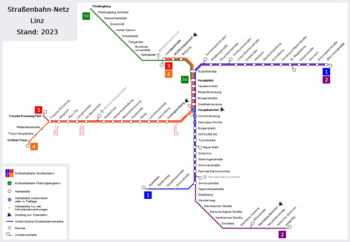
The Linz Linien (formerly ESG, now part of the Linz AG Group) are the most important pillar of inner-city public transport as the operator with the tram , trolleybus and city bus routes. This is supplemented by the AST (collective call taxi), which runs in certain Linz areas during the day and within Linz and in some neighboring communities at night.
On December 5, 2004, the Linz local transport hub went into operation. The centerpiece is an underground tram route between the Bulgariplatz and Goethekreuzung stations (1.9 km in length), which was opened on August 31, 2004. This created a direct connection to the newly built main train station. The planning of this line variant goes back to 1976. After much back and forth, construction began in 2001 and was completed in 2004 - three months earlier than planned. In addition to the train station, a new bus terminal was also built under the state service center.
The Upper Austria S-Bahn went into operation on December 11, 2016 and connects Linz Central Station with the surrounding area. The S-Bahn has 5 lines that run over the West , Rudolfs , Pyhrn and Summerauerbahn as well as the Linz Local Railway . It is planned to expand the S-Bahn by two lines to the north. For this purpose, a tram line is to be built from the main train station to Urfahr. One line is to run over this new light rail line and the Mühlkreisbahn , the other line over this light rail line and on a new line to be built via Gallneukirchen to Pregarten .
Bicycle traffic
At 5%, the share of cycling in Linz is low compared to other cities with a similar population (e.g. Salzburg : 18%, Graz 14%, Münster 38%, as of 2004). Although the city of Linz is endeavoring to open up suitable one-way lanes for cyclists, and getting around on the bus lanes is also made easier, the actual cycle paths often end precisely where the traffic situation would require them most. Some parts of the city are only accessible or passable on roads with heavy traffic. Therefore, the Bicycle Initiative (Upper Austrian subsidiary of ARGUS ) calls for a multi-year focus campaign to expand the Linz cycle path network.
Linz is on the busy Danube Cycle Route R1 between Passau and Vienna . This is one of the most popular long-distance cycle routes in Austria and Germany. According to the ADFC certification program, the Danube Cycle Path was awarded four stars as the No. 1 quality cycle path . The criteria for this evaluation are good signage, safe routes and an attractive tourist infrastructure. There are numerous bike-friendly accommodations with e-bike charging stations along the route . In Linz, the Danube Cycle Path runs along the newly designed banks of the Danube with the Ars Electronica Center, the Lentos Art Museum, the Brucknerhaus, the tobacco factory and the nearby old town of Linz with its promenade and cathedral.
Shipping traffic and ports
Until 2011, Linz was the largest port in Austria and the Upper Danube . It is located on the largest waterway in Europe, which thanks to the Rhine-Main-Danube Canal enables a continuous water connection between the North Sea and the Black Sea . Around 6.9 million tons of goods were transshipped in the municipal port of Linz AG and in the voestalpine works port in 2005 . In the immediate vicinity is the Enns port , which has been greatly expanded in recent years , and is another of the four Austrian Danube ports.
In 2005, of the 6.9 million tonnes, around 0.6 million came from the trading port, 0.6 million from the tank port, 1.9 million from the container port and 3.8 million from the voestalpine port.
The total area of the port facilities is around 150 hectares , of which 45 hectares were water until 2011. A large-scale redesign, which should bring a further increase in capacity, began in 2012. Port basins that are no longer required are filled in and used for warehouses and administration buildings. For this, the retained part is modernized and redesigned.
There is also increasing passenger ship traffic in Linz , especially Danube cruise companies and day trips.
From 2015, silos that are no longer needed are to be demolished at the port, buildings modernized and rebuilt and a new level (above commercial halls) set up for culture at a height of up to 18 m: within walking distance of the Posthof venue and stairs down to the Harbor basin.
Airport
Linz Airport is located in Hörsching and has regular connections to Düsseldorf , Frankfurt am Main and Vienna . There are low-cost flights to London with Ryanair (3x per week). There are also some charter connections to Egypt , Greece , Italy , Croatia , Spain , Tunisia and Turkey .
The airport has a certain importance as a location for air freight - forwarders . There is a weekday cargo flight to the DHL hub in Leipzig . The only Austrian cargo airline Amerer Air was based in Linz . In 2014 the airport was frequented by around 561,000 passengers and 44,414 tons of freight were handled. In the following year the number of passengers was 529,785 and the freight increased to 45,985 tons.
Social affairs and security
In Linz there is
- 7 urban retirement homes with 1,249 care places,
- 7 private retirement homes with 821 care places,
- 3 day centers for seniors with 110 care places,
- 144 serviced apartments ,
- 19 senior clubs (called Active Club),
- 9 urban crèches with 212 childcare places,
- 90 childcare places ,
- 46 municipal kindergartens with 3,376 places,
- 39 private kindergartens with 1,911 childcare places,
- 31 urban after-school care centers with 2,880 childcare places,
- 8 private after-school care centers with 529 childcare places,
- 13 youth centers ,
- 3 youth information and advice centers,
- 3 street work projects ,
- 1 house for children and young people with 24 places,
- 1 youth flat-sharing community "SISAL" with 8 places,
- 6 homeless shelters with 245 places,
- 1 women's shelter with 14 childcare places,
- 1 mother-child house with 8 childcare places,
- 9 private parent-child centers,
- 1 municipal parent-child center in Ebelsberg ,
- 1 family center in the Solar City in Pichling ,
- 15 parent and mother advice centers,
- 1 "SOMA" social market (private),
- 5 social stations ,
- 3 "Kompass" social counseling centers,
- 120 sponsored social associations.
Healthcare
In Linz there are (as of 2016)
- 7 hospitals ,
- 170 specialists ,
- 37 pharmacies and
- 2 emergency services.
- Hospitals
-
Kepler University Hospital , consisting of the following areas:
- Med Campus III, until the end of 2015 the General Hospital (AKh) with 996 beds and a total of 2,513 employees
- Med Campus IV , until the end of 2015 the state women's and children's clinic with 268 beds
- Neuromed Campus, until the end of 2015 the State Neurological Clinic Wagner-Jauregg with 731 beds
- Accident hospital (UKH) with 155 beds
- Brothers of Mercy Hospital with 372 beds
- Ordensklinikum (merger on January 1, 2017)
- Sisters of Mercy Hospital with 713 beds
- Elisabethinen hospital with 481 beds
- Deaconess hospital with 116 beds
- Day clinic Linz with 14 beds
Rescue organizations that also perform other tasks:
education

Elementary, secondary and vocational schools
- Public compulsory schools: a total of 11,844 students (school year 2004/05)
- Private compulsory schools: a total of 699 students (school year 2004/05)
- 2 elementary and 2 secondary schools
- 15 general education colleges with 9,755 students (school year 2004/05)
- I.a. (also former) religious educational institutions such as the Adalbert-Stifter-Gymnasium , the Kollegium Aloisianum , the Episcopal Gymnasium Petrinum and the Gymnasium of the Cross Sisters Linz
- 10 vocational middle and high schools with 3,259 students (school year 2004/05)
- 2 educational institutions for kindergarten pedagogy with 785 students (school year 2004/05)
- 10 vocational schools with 10,200 students (school year 2004/05)
Universities and colleges
- Johannes Kepler University Linz with 19,930 students (as of 2017/18)
- University of Art and Industrial Design Linz ( Art University Linz ) with 1,334 students (as of 2017/18)
- FH Upper Austria , Campus Linz, with 879 students (as of 2017/18)
- Anton Bruckner Private University for Music, Drama & Dance with 871 students (as of 2017/18)
- Pedagogical University of the Federal Upper Austria with approx. 3,000 students
- Pedagogical University of the Diocese of Linz
- Catholic Private University Linz with 341 students (as of 2017/18)
- LIMAK Austrian Business School
- KMU Akademie AG ( Middlesex University London )
Libraries
In September 2007 the “ Knowledge Tower ” was completed next to the main train station , in which the Linz main library and the adult education center are housed. In 2007, the expansion of the state library on Schillerplatz began.
- Main library and ten branches: 1,159,212 loans (2013)
- State library: 86,262 loans (2005)
The main library is the largest public library in Upper Austria. The library has a collection of 220,000 media, including around 60,000 audio-visual media, as well as numerous magazines. The library also offers public Internet access and computers for surfing. The city library has set itself the focus on promoting reading. In addition, there are regular events such as readings, workshops or eReading consultation hours.
Adult education
- Adult Education Center (VHS Linz) with 24,994 course participants (course year 2004/05)
- Vocational Promotion Institute (BFI) with 56,300 course participants (course year 2010)
- Economic Development Institute (WIFI) with 41,726 course participants (course year 2004/05)
- Education center of the security executive (BZS) Linz of the security academy
police
The state police department of Upper Austria acts as the security authority for the city . As a service of the constabulary for the urban area that it is Stadtpolizeikommando Linz assumed.
Fire brigades
One of the six professional fire departments in Austria is located in Linz . Four volunteer fire brigades (Ebelsberg, Pichling, Pöstlingberg, St. Magdalena) and nine company fire brigades complement the Linz fire department. In addition , the regional fire brigade school , which is subordinate to the Upper Austrian regional fire brigade association , is located in Linz and carries out the training of fire brigade members of all Upper Austrian volunteers and company fire brigades .
Care and maintenance
The city of Linz offers urban senior centers for the care of the elderly and those in need of care. In addition, private organizations run old people's and nursing homes, for example Diakonie, the house for seniors in Körnerstraße and Caritas Upper Austria, the St. Anna and Karl Borromäus retirement homes.
leisure
Parks and recreation areas
The city of Linz has a large number of parks as well as several larger recreational areas, which are mentioned below:
- Lakes and outdoor pools: Pichlinger See , Pleschinger See , Weikerlsee , Biesenfeldbad, Hummelhofbad, Parkbad, Schörgenhubbad. The bathing lakes in Linz are free for visitors and are among the cleanest in Austria. The water quality measurements have been rated “good” in recent years. The analyzes of the water are carried out by AGES. The Pleschinger See, the Pichlinger See and the Weiklersee are looked after by Linz AG. The first swimming pools in the city were those in the former “factory arm”, a side arm of the Danube that was filled in around 1890 in the bend of the Danube (from today's Parkbad to around Winterhafen). Afterwards, a "Strombad" (stream in the sense of the Danube River) was built as a temporary measure on the Upper Donaulände, which existed until the flood in 1954. In 1901 the new “Municipal Swimming School” was built on the site of today's park pool.
- Botanical Garden : With around 100,000 visitors, the Botanical Garden is one of the best-visited facilities in the city. Located on the Bauernberg, around 4.2 hectares in size, which has existed since 1952, impresses with its harmonious design, its wealth of plant species (around 8,000 different species in culture) and the rich cultural and event program.
- Donaulände or "Lände": public park on the Danube between Lentos and Brucknerhaus. Popular meeting place for young people in Linz in summer. Location of the Linz Klangwolke .
- Freinberg : public park, very popular with families and joggers. One of the most beautiful residential areas in Linz.
- Pfenningberg : Part of the northeastern green belt towards Steyregg with a view of the port facilities and the VÖEST site
- Water forest : Large park (approx. 1 km²) in the south of Linz in the Kleinmünchen district in which there is a large waterworks. Popular with walkers, joggers, Nordic walkers and dog owners. The park is equipped with well-maintained sidewalks, children's playgrounds, two toboggan hills, a fitness path, a running track and a senior park with free chess. There are also two public toilet facilities.
- City park : On August 22, 2003, the new Linz city park between Huemerstrasse, Museumstrasse, Noßbergerstrasse and Körnerstrasse was officially opened. At 10,807 square meters, the green area is the second largest inner-city park. The city of Linz acquired this area through an exchange deal with the Austrian post office . Since the Schillerpark in 1909, there has not been a new park of this size in the inner city of Linz.
- Landscape Park Bindermichl-Spallerhof : The State of Upper Austria was responsible for the first stage of expansion of the 8.3 hectare area that connects the districts of Bindermichl and Spallerhof . The park replaces the city motorway, which has been running underground in this area since 2006. Old paths could be re-established and by about mid-2007 the city gardeners designed the new park landscape with 550 trees and various shrubs, shrubs and flower beds, which give the park a diverse appearance.
- Linz Zoo : The Linz Zoo is located on Pöstlingberg and houses around 600 animals from 110 different species on four hectares. In 2016, the 3500 m² "pet park", with animals such as the pot-bellied pig or the Valais black-necked goat, was opened. The park brings animal lovers closer to the diversity of rare domestic and farm animal breeds. In the same year, the zoo attracted 132,400 visitors and broke the visitor record again.
- Kirchschlag : The ski area is located 15 km north of Linz and has three tow lifts: the house lift, the forest lift and the baby lift. The special features of the ski area include the “How fast am I - route”, in which an automatic timekeeping system measures the time traveled, or evening skiing. The ski area also has a 2 km long cross-country ski run, an ice rink and a natural ice rink.
- Urban forest: 18 percent of the total of 96 square kilometers of the city are forested and thus take up to 1,724 hectares of forest, 74 hectares more than in 2004. Linz is ahead of Graz in the urban forest area ranking, even if the company only owns 500 hectares City itself. These are managed and cared for in a sustainable manner, with 87 ha being used, 46 ha being used as a protection, 30 ha being used as a recreational area and 353 ha being used as a welfare function. The latter represents the main function of the Linz Forest.
In the densely built-up inner-city area, the smaller parks also play an important role as “green oases”. There are several such small green spaces along the main axis of downtown Linz , the Landstrasse . On the one hand, there is the Landhauspark , which was redesigned in the course of building an underground car park until 2009, whereby the old trees were retained. Also in the city center is the Hessenplatz or Park, which was created in 1884 as the center of the Neustadtviertel . Directly on Landstrasse is the Schillerpark, which took the place of a train barracks in 1909, and the Volksgarten , which was laid out by an entrepreneur in 1829 and bought by the city in 1857.
Donausteig
The Donausteig is a non-alpine, 450-kilometer-long Austrian - Bavarian long-distance hiking trail divided into 23 stages, and since the summer of 2010 it has mostly led along the two banks of the Danube from Passau via Linz to St. Nikola and Grein . The Donausteig runs largely in nature and leads to popular landscape and viewpoints.
Harbour Cruise
A 100-minute harbor tour on board the design ship "MS Linzerin" takes place three times a day (Tuesday to Sunday) from the end of April to the beginning of October. The journey begins in the Linz Danube Park, runs along the Linz culture mile, passes the Brucknerhaus and ends in the harbor area with the entrance to the ÖSWAG shipyard in Linz .
Culture
The most famous Linz cultural event is the annual Linz Sound Cloud as part of the Bruckner Festival . The Ars Electronica , festival for art, technology and society, has quickly become a flagship of the cultural city. In addition to the international street art festival Pflasterspektakel , which has been taking place annually since 1987 , numerous permanent institutions also enrich Linz’s cultural life. The previous Linzfest was followed for the first time in 2018 by the urban music festival Stream in the center of Linz, which also offers workshops, the Stream Talk .
The Bruckner Orchester Linz , best known as a symphony and opera orchestra, since September 2017 under chief conductor Markus Poschner has regularly accompanied performances in the music theater. As the house orchestra of the Linz State Theater, there are also guest appearances in the Brucknerhaus.
In Linz there are 43 galleries and exhibition rooms, 13 Volkshäuser (267,693 visitors (2009)), a club center (20,817 visitors (2004)) and four “educational houses”. The Linz Kulturcard 365 offers discounts and offers as well as free entry to many of these facilities.
After the Anschluss in 1938, Linz became a playground for National Socialist power fantasies for a short time. As a youth town Adolf Hitler and guide City Linz should not only become a major industrial and commercial city, but also a European art metropolis.
In 1986 Linz declared itself a “City of Peace”, the aim of which is to counteract all political extremism, racism and anti-Semitism. Part of this commitment was and is the critical examination of the city's National Socialist past.
In 2009 Linz was the European Capital of Culture . The “ Capital of Culture Linz ” project was financed in equal parts by the federal government, the state and the city (20 million euros each), small subsidies from the EU, sponsorship money and income from the sale of tickets and merchandising items. A total of around 70 million euros was available for the renovation, expansion and construction of cultural institutions such as the Ars Electronica Center (AEC), the music theater (which, however, only opened in April 2013) or the acquisition and adaptation of exhibition spaces were used. At the same time, measures to beautify the city were taken: For example, the redesign of the promenade in the course of the construction of the underground car park, as well as the redesign of the parish square.
On December 1, 2014, Linz was included in the international network of UNESCO Creative Cities (UCCN) as the “City of Media Arts” . “In over three decades Linz has established itself as a location for digital media art and Ars Electronica with the festival, the AEC and the Futurelab as a brand for innovation and creativity. The inclusion in the international network (...) underscores the internationality and the longstanding know-how that Linz has represented for years, ”said Mayor Klaus Luger. 69 cities worldwide currently belong to the Creative Cities network, which is divided into seven thematic categories: literature, film, music, folk art, design, media art and gastronomy. The network is intended to facilitate the development of existing potential, strengthen local and international cultural developments and create jobs that promote the development of social and economic goals in cities. The title “City of Media Arts” is awarded to cities that successfully promote and integrate media art , thereby enriching urban life and integrating civil society into these electronic art forms. In addition to Linz, there are seven other cities that can call themselves City of Media Arts : Enghien-les-Bains , Lyon , Sapporo , Dakar , Gwangju , Tel Aviv-Jaffa and York .
Together with St. Pölten , Linz is part of the “Culture connects” campaign. The price includes a ticket for a performance in the Landestheater Linz or in the Brucknerhaus as well as the Linz Card, which guarantees free entry to all Linz museums. The card can also be used as a ticket for public transport and offers additional offers and discounts on cultural activities in Linz and St. Pölten.
architecture

Realized principles
As is typical of a Central European city, the cityscape of Linz is primarily characterized by rather low, evenly built structures and numerous sacred buildings. Apart from the medieval old town in the city center, the prevailing architectural styles of the districts clearly indicate the era in which they experienced their greatest expansion and population growth. In the city districts directly adjacent to the old town, especially in the city center , the historicist architectural style of the Wilhelminian era prevails , which is recognizable through facades in the styles of neoclassicism , neo-baroque and neo-renaissance . If you move further away from the historic old town, you penetrate into residential areas such as the Franckviertel , Froschberg or the Bindermichl or Kleinmünchen . The residential buildings located there, predominantly in the Heimatschutz style , often date from the interwar period as well as the Nazi era and are recognizable by their simple facades and construction as large rental housing complexes, so-called " Hitler buildings ", often laid out in courtyard form. The city districts north of the Danube, apart from Alt-Urfahr, also have many residential complexes of this type and this time. The Gugl , which became a popular residential area for the upper class around 1900 and houses numerous villas, is an exception in this regard .
New building after 1945
After the Second World War, in order to alleviate the housing shortage and to replace houses destroyed by aerial bombs, many rental houses were built again, most of which managed without any facade design. Between 1950 and 1970, some of the historic buildings that shaped the cityscape of Linz were demolished. B. the Linzer Wollzeugfabrik , the Schloss Hagen or the Hotel Weinzinger . The 1970s, in particular, represented a major cut in the cityscape, when most of the high-rise residential buildings that can be seen today in the cityscape were built. A decision was made in favor of this type of building construction, which had practically not been found in the cityscape until then, as the demand for housing, which had been constant for many years, was finally to be noticeably alleviated. The ten to 15 storey high rental houses that were built at the time were architecturally simple and inexpensive to build in order to achieve quick results. They were mainly built outside of the densely built-up city center in vacant lots or on new building sites. Because of their unimaginative design in box form, these, as well as some high-rise office buildings that were built at roughly the same modest height at the time, are predominantly viewed as building sins. During this time of expansion of the city and the great population growth, in addition to such unpopular buildings, large building complexes such as the Lentia 2000 and the Sparkasse high-rise in the Urfahr district became possible. The New Town Hall dates from 1985 . This building, designed as a "walkable hill", is the largest structure in the district.

After the bad experiences with high-rise construction in the 1970s, the city set up a design advisory board a few years later, which from now on was supposed to protect the city from “future building sins”. For a long time now hardly any high-rise buildings were built. It was not until the end of the 1990s that there were renewed considerations of building high-rise buildings in today's modern style. The construction of a 150 meter high, glass-facade high-rise office building with the name “Skygarden Tower” was considered on a Voest sports field. In the end, however, the project did not materialize. However, the Lenaupark residential and commercial complex was built in 2004 , which includes two high-rise office buildings, including the city's tallest building (excluding the sacred building), the 67-meter-high City Tower 1 . A 19 storey high office building in the city center on Gruberstrasse was approved by the design advisory board, but not implemented by the client.
This was followed by the construction of the 63-meter-high Knowledge Tower , which was officially opened on September 14, 2007. The 99 meter high “Terminal Towers” of the Austrian Federal Railways (ÖBB) at the main train station and the new, 73 meter high headquarters of Energie AG were built in the immediate vicinity . These buildings shape the new appearance of the Bahnhofviertel, which already had distinctive, glass-fronted new buildings with the state service center and the new main train station. In addition to these high-rises, which because of their suitable locations that do not disturb the cityscape (station district) and their modern architecture, which uses a lot of glass facades, as well as the fact that they are office and not residential buildings, met with little resistance from the population Further large residential and commercial construction projects are already being planned for the following years. Currently (end of 2013) apartments and offices for several hundred people are being built on the site of the former freight station.
Apart from the high-rise construction, the expansion of the urban development towards the city limits was resumed, especially from the 1990s. Above all in the south of the city, as well as in undeveloped areas in the inner-city and inner-city districts, many architecturally modern and visually rather restrained rental housing complexes were built. With the construction of the Solar City at the southeast end of the city, in Pichling southwest of the Weikerlsee, the city also realized a future-oriented residential project that was designed to save energy and energy efficiency, which was laid out in a circle and includes row houses with gardens for 5,000 people.
On April 5, 2006, the design by the London architect Terry Pawson for the new Linz Music Theater was selected as the winning project in an architectural competition. The special thing about this project is that Blumauer Straße was moved behind the theater to the railway, the previous traffic junction Blumauerplatz was built over and the Volksgarten on the other side was included as a kind of extended foyer . In April 2009 the groundbreaking ceremony took place for the building, which was erected in several stages by 2013. The music theater was officially opened on April 11, 2013 and has served as the city of Linz's theater and opera house ever since.
Highest building
According to the Upper Austrian Building Technology Act, a high-rise is a building whose eaves height is higher than 25 meters on each side or the upper edge of the floor on the top floor is higher than 22 meters above the adjacent area on all sides. According to this definition, as of February 2007 there were 233 high-rise buildings in Linz. The ten tallest buildings in the city (excluding transmission masts and industrial structures such as the 84 meter high voestalpine blast furnace) are:
| serial no. | Surname | completion | use | Height in meters |
|---|---|---|---|---|
| 1 | Mary's Conception Cathedral (New Cathedral) | 1924 | church | 135 |
| 2 | Terminal Tower | 2008 | offices | 99 |
| 3 | Lux Tower | 2017 | Living | 80 |
| 4th | Blumau Tower | 2011 | offices | 74 |
| 5 | Power Tower | 2008 | offices | 73 |
| 6th | City Tower Linz | 2004 | Offices, businesses | 67 |
| 7th | BLICK.punkt | 2013 | Living | 64 |
| 8th | Knowledge tower | 2007 | Education, administration | 63 |
| 9 | Blossom Street 23 ( Lentia 2000 ) | 1977 | Living | 59 |
| 10 | Rilkestrasse 20 (Lenauhochhaus) | 1959 | Living | 56 |
Selected structures and streets
- Pilgrimage basilica Pöstlingberg ( Pöstlingbergkirche ): Landmark of Linz, pilgrimage church high above the city at 537 m above sea level; Built 1738–1774.
- Pöstlingbergbahn : Steepest cogwheelless mountain railway in the world ( adhesion railway with 10.5% gradient), built in 1898. End of the line in a tower of the fortress belt (around 1830).
- Linzer Grottenbahn : on the Pöstlingberg, opened in 1906 in a former fortification tower of the fortress. Circular train in a small train and showrooms provide insights into the fairytale world of children and the Linz main square around 1900.
- Mary's Conception Cathedral : also “New Cathedral”, built from 1862 to 1924, neo-Gothic sandstone building with unfinished details; largest church in Austria (holds 20,000 people); After St. Stephen's Cathedral, the second highest church tower in Austria (tower height: 134.8 meters)

- Old Cathedral : Church ( Jesuit Church ) from 1669 with two towers (until 1805 with onion helmets)
- Country house : Italian early Renaissance building from 1564. Planetary fountain, built in 1648.
- Hauptplatz : largest city square on the Danube; with Trinity column from 1717 and the old town hall
- City parish church : Late Romanesque complex, modified in 1648 in Baroque style. The heart and bowels of Emperor Friedrich III, who died in 1493 . were buried here.
- Linz Castle : first documented mention in 799. Residence of Emperor Friedrich III. Since 1966 castle museum with historical and folklore collections.
- Martinskirche : first mentioned in 799, was at times the oldest surviving church in Austria. However, research over the past 25 years has shown that this is not tenable. In 1978 a Carolingian central building was excavated, the current floor plan results from a reconstruction probably in the 10th or 11th century
- Hotel "Zum Schwarzen Bären": Birthplace of the tenor Richard Tauber , where he was born on the evening of May 16, 1891. The house in which he was actually born in Herrengasse no longer stands today; it was replaced in 1925 by a new building that has since been changed.
- “Mozarthaus”: Wolfgang Amadeus Mozart stayed here at the beginning of November 1783 as a guest of the Count of Thun. During this time he composed the Linz Symphony in three days. Josef Urbanski (the planner of the Pöstlingbergbahn) also lived here between 1893 and 1895. The building was erected in the second half of the 16th century.
- Landstrasse : the Landstrasse forms the main urban development axis of Linz; where there are many historical buildings and sights, such as the Ursuline Church and the Carmelite Church . It is the shopping street with the third largest number of visitors in Austria.
- Ebelsberg : Ebelsberg Castle was first mentioned in 1154 and was the scene of armed conflicts for centuries, the best known of which was the battle of Ebelsberg during the Napoleonic Wars. The Ebelsberg parish church with the only Art Nouveau apse in Upper Austria.
- Friedenskirche : built from 1933 to 1951 in the modern style by Peter Behrens , Alexander Popp , Hans Feichtlbauer and Hans Foschum ; inside: fresco by Max Weiler and life-size Pietà by Adolf Wagner von der Mühl .
- In Linz there are still old farms (especially on the outskirts of the city, but also in areas that are now densely built-up), many of them traditional square ones , see the list of farms in Linz
graveyards
There are over 13 cemeteries in the city of Linz, four of which are looked after by LINZ AG.
- Cemetery of the Israelitische Kultusgemeinde : The Israeli cemetery has been a listed building since October 15, 2009. Due to an agreement with the city parish, the cemetery survived the Nazi era. On the one hand, the cemetery differs from Christian cemeteries due to the lack of floral decorations. The graves here are overgrown with ivy and grass.
- Ebelsberg cemetery : The former Ebelsberg cemetery was first mentioned in a document in the 13th century. The cemetery has also been a listed building since October 15, 2009.
- Pöstlingberg cemetery : The cemetery dates back to 1785. The wrought iron grave crosses are characteristic.
- St. Margarethen Cemetery : With only 40 graves, the St. Margarethen Cemetery is the smallest cemetery in Linz.
- St. Magdalena Cemetery : According to tradition, the cemetery goes back to the 17th century. It was rebuilt in 1835 and has been expanded several times since then.
- Urfahr cemetery : The cemetery was laid out in the garden of the Capuchin monastery in 1786 and has served as the cemetery of the Urfahr parish ever since.
- Military cemetery at Petrinum : 563 victims of the First and 22 of the Second World War are buried in the military cemetery. The cemetery is a memorial against war and for peace and is a listed building.
- St. Barbara Cemetery : The St. Barbara Cemetery has been expanded several times and is open to all denominations.
- Stadtfriedhof Linz / St. Martin : With an area of 60 hectares , the Stadtfriedhof Linz is the largest and youngest cemetery in the city.
- Urn Grove Fire Hall : The construction of the Urn Grove was initially highly controversial, as the Catholic Church saw cremation as unchristian.
- Urnenhain Kleinmünchen : In the meantime, no more burials are carried out here and the existing graves will have to make way for the urns over time.
- Urnenhain New farewell hall : Construction took place in 2002/03.
- Urfahr urn grove : The Urfahr urn grove has been a listed building since October 15, 2009.
Regular events
- Ahoy! Pop. Time music at the port : Since autumn 2011, Ahoi! Has been taking place in the Posthof Linz for a week. Pop instead. The motto of the different musical styles is “There has to be something!” And offer visitors a mix of current and urban music. Since 2016 the open-air festival “Ahoi! The Full Hit Of Summer “takes place in the Donaupark.
-
Ars Electronica : international festival for media art , which took place for the first time in 1979 and has been held annually since 1986. The symposia, exhibitions, performances, interventions and concerts that take place during the multi-day festival are dedicated to a specific topic each year, for example “C… what it takes to change” (2014 theme). In 2015 around 92,000 visitors visited the Ars Electronica Festival.
- The theme for 2016 was "RADICAL ATOMS and the alchemists of our time".
- In 2017 the festival was dedicated to the motto "Artificial Intelligence - The Other Me".
The festival takes place in various public spaces and sees itself as a discussion with and in public.
- Black Humor Festival : Every two years in May, the Black Humor Festival takes place at the Posthof in Linz with guests from all over Europe. The last performance of the festival was from 2. – 28. May 2015.
- Bubble Days : two-day event in the Linz trading port, with street art and graffiti , extreme sports and live music. The Bubble Days are organized by the Linz creative group LI.KIDO. has been held since 2011 and has been held annually in June since then. Around 12,000 visitors (2013).
- Crossing Europe Film Festival : international film festival of contemporary European auteur cinema that has been held annually in Linz since 2004. While the festival registered 9,000 visitors in 2004, the number of visitors has now increased to 20,000 (2013).
- Danube in flames : annual musical fireworks from June to August in Upper Austria on the banks of the Danube, accompanied by a broad supporting program. “Danube in Flames inspires thousands of visitors every year. From the bank, Bengali fires and fireworks are ignited synchronously to thematically coordinated music and let the Danube shine in colorful lights. "
- Festival 4020 [more than music] : Since 2001 the festival "4020" has taken place regularly all over Linz. Young composers, musicians and ensembles perform at various venues and play both classical works and modern interpretations.
- Festival of the Regions : contemporary art and culture festival. Has taken place every two years since 1993 in a different region of Upper Austria.
- Festival for Children's Rights : The festival sees itself as a child-friendly festival and a platform for children's rights.
- Höhenrausch : The Höhenrausch is an annual art project that was developed in 2009 as part of the European Capital of Culture year. As part of DonauArt, a cross-institutional cultural project, the 2018 Höhenrausch had the motto “The other bank”. The element of water was worked on by international artists, with the definition of the shore being the focus of the artistic debate. The various rooms and locations underlined the presentation of this project. The project "Flying Ship" by the Russian artist Alexander Ponomarev, which symbolizes the departure to the other bank, will remain installed for a long time after the end of the high altitude in 2018.
- International Bruckner Festival : One of the most renowned series of music events in Austria, which takes place in the Brucknerhaus and other venues - annually in September / October since 1977. The namesake of the music event series is Anton Bruckner, the organizer is the Brucknerhaus. The 2018 Bruckner Festival took place from the composer's birthday on September 4th until the day of his death on October 11th. This date will be kept annually until the 200th year of commemoration for Anton Bruckner in 2024. Every year this music festival is dedicated to a new topic, in 2018 the motto was “Bruckner and tradition”.
- International TriRun Linztriathlon : up to 1,000 participants and 5,000 visitors.
- Youth hacking Austria : Computer and technology fans between 12 and 18 years of age spend a weekend in Linz hacking , programming and tinkering for a vision of a better society.
- Children's film festival : The international children's film festival is organized by Kinderfreunde OÖ. The films are shown in their original version while an actor dubbed the film live.
- Children's Culture Week : The Children's Culture Week has been taking place regularly since 2013. There are plays, workshops and a. Trial courses for children and teenagers.
- Klangwolke : musical event in the Danube Park that has opened the International Bruckner Festival every year since 1979. Since 1985 there has also been a “Visualized Sound Cloud” in addition to the “Classic Sound Cloud”, and since 1998 a “Children's Sound Cloud”. Around 110,000 visitors (2013).
- Long night of the stages : programs are offered at 30 venues until after midnight. Performances are not only performed in theaters, but also in libraries, cultural associations or, among other things, in a double-decker bus.
- Long Night of Research : The Long Night of Research has also been held in Linz for seven years. Universities, clinics and companies explain complex topics in an understandable way.
- Long Night of Churches : The Long Night of Churches takes place every June. The event, which was launched in 2004, deals with the main topics of religion and various denominations as well as the focus on church architecture.
- Long Night of Museums : In 2016, the Long Night of Museums will take place across Austria for the 17th time. Galleries and museums are open from 6 p.m. to 1 a.m. Special events are also offered.
- Linz Marathon : The major event with around 20,000 participants and more than 100,000 spectators (2019) has been held annually in April since 2002.
- Art and design market: Annual market in the tobacco factory.
- Linz Auto Spring : The Linz Auto Spring is one of the largest auto shows in Upper Austria. Current vehicle offers and the latest vehicle models have been presented since 1971.
- Linz Christmas markets
- LINZ FMR : The festival is dedicated to art in digital contexts and public spaces. The first edition of the biennial format will take place in March 2019 at the Linz Donaulände.
- Linz International Short Film Festival : The Linz International Short Film Festival is the first film festival in Upper Austria that focuses on international short films. The first edition with 114 films over four days took place in October 2018 in Moviemento (Linz) . Festival director Parisa Ghasemi is responsible for the concept.
- Linz Krone Festival : With 12 stages and over 70 concerts, the Linz Krone Festival, which has been taking place since 2000, is one of the largest open-air concerts in Upper Austria.
- Linz Story : The international storytelling festival founded in 1988 is one of the most important storytelling festivals in Europe. In addition to Linz, the festival also takes place in Graz, Vienna and Lower Austria.
- Linz Day of Languages : takes place every year in September on the occasion of the European Day of Languages. The event lasts one week and is based on an initiative of the Council of Europe .
- MUSEUM TOTAL : Together with the tourism association, nine museums in Linz offer a special program during the semester break. In addition to exhibitions, workshops, short tours and special events are held for the whole family. The aim of the event is to draw attention to the museums in Linz and to experience the diversity of art and culture.
- Family night : A total of 13 different institutions in Linz open their doors during the family night from 6 p.m. to midnight and invite you to explore.
- NEXTCOMIC : The NEXTCOMIC Festival took place for the first time in 2009 and is unique in Austria as it focuses on the connection between comics and fine arts.
- Pflasterspektakel : multi-day street festival with local and international artists that has been taking place in downtown Linz every year since 1987. There is object and impro-theater, high wire and fire acrobatics, music, dance and performance, clowning , juggling and comedy. Around 230,000 visitors (2013).
- Schäxpir : An international youth and theater festival in Linz and Upper Austria since 2002. “SCHÄXPIR offers innovative and courageous theater for young people. New and unusual approaches and varieties are the program. The festival has been adhering to the principle of showing demanding and high-quality productions since 2002! "
- View: change : The cultural festival, which has been taking place regularly since 2007, presents art and aesthetics of people with disabilities.
- Summer in the rose garden : from June to August, visitors are offered a mix of theater, music and cabaret programs every year.
- Steirisch Herbst'ln : event that takes place every four years and is organized by Steirische Tourismus GmbH.
- Stream Festival : An open-air music event with free entry at several locations in Linz. The first edition of the Stream Festival, as the successor to the Linzfest, took place from May 31 to June 2, 2018. At the center of the festival - in keeping with Linz as a UNESCO City of Media Arts - is digitization. In addition to electronic music, the festival also offers workshops, lectures and talks.
- TGW Lentos Jump : In 2015 the pole vault of a different kind started its first round. The first pole vault competition took place on the covered area below the LENTOS Art Museum as part of a day of exercise on the subject of athletics. An additional highlight of the sporting event is the mirrored ceiling of the Lentos.
- Shores : Annual Danube Beach Festival in Alturfahr.
- Urfahraner markets in spring and autumn: around 500,000 visitors each.
- Wine & Art : The wine and culture festival has been held annually in Linz's old town since 1994.
Cultural institutions and sights
Museums

- Ars Electronica Center / Museum of the Future: Museum for Electronic Art in Linz-Urfahr at the bridgehead of the Nibelungen Bridge: 175,261 visitors (2013). Right from the start, Ars Electronica has been looking for connections and overlaps, for causes and effects between art, technology and society. It calls artists, scientists and researchers from all over the world to Linz to deal with a specific topic in exhibitions, lectures, workshops and symposia. Trying out, evaluating and reinventing is the desired methodology for the discussion and should provide an answer to what brings us humans a step further as a society.
- Lentos : The museum for modern and classical art on the Donaulände was opened in 2003. Because of the clear architecture , it is not without controversy among the population. 71,000 visitors (2013). The museum created by the Zurich architects Weber & Hofer has already become a Linz landmark with the nightly illumination of its glass envelope. In the immediate vicinity of the Danube, between the Nibelungen Bridge and the Brucknerhaus, it is only a few minutes' walk from the main square and at the same time offers relaxation in the spacious, green bank area. Large rooms on the upper floor guarantee a daylight-rich exhibition space, as does the exhibition hall, which is also the largest museum space in Austria. Graphics and media art are housed in the basement, as well as the foyer, shop, an auditorium with 250 seats, a flexible room for art education and the library complement important public areas, including the popular café-restaurant with its Danube panorama terrace. With its constantly expanding collection, the Lentos Art Museum Linz is one of the most important museums of modern and contemporary art in Austria, from masterpieces of European painting from the first half of the 20th century to graphic collections and photo holdings. Lentos spans the range between the classic-historical art of the early 20th century and the latest contemporary art.
- City Museum Nordico : The collection consists of an art collection, the city history and the archaeological collection, each with a strong contextual reference to the city of Linz. 16,000 visitors (2013).
- Dental Museum: Museum for the development of dentistry and dental technology, the oldest exhibits of which date from 1720. 1,680 visitors
-
Upper Austrian Provincial Museum :
- Francisco-Carolinum / Landesgalerie: modern and contemporary art, 23,400 visitors (2013).
- Schlossmuseum Linz : archaeological museum, 89,500 visitors (2013).
- Biology Center Linz-Dornach: Natural history collection with more than 16 million exhibits, 11,400 visitors (2013).
- Upper Austrian Art Association : Association for the promotion of contemporary art (founded in 1851), with a gallery in the Ursulinenhof
- StifterHaus - Center for Literature and Language in Upper Austria: Seat of the Adalbert Stifter Institute, a research center for literature and linguistics, and the Upper Austrian Literature House, a venue for readings, scientific lectures, symposia, etc. a.
- Architekturforum Oberösterreich in the House of Architecture: lectures, exhibitions and conferences, competitions and project developments. 6,000 visitors.
- Open House of Culture Upper Austria : Art facility for the presentation and development of contemporary art with a focus on installation and media works
- Fatsy Cowboy Museum (open April to June): Museum of cowboy culture, with exhibits from America, 2,100 visitors.
theatre
- State Theater : Large House (121,214 visitors) and Kammerspiele (81,055 visitors), Ursulinenhof ( u / hof , 12,215 visitors) and Eisenhand-Theater (11,564 visitors).
- Music theater : Theater and opera house of the city of Linz. Built between 2008 and 2013 and opened in April 2013. 162,500 visitors (2013).
- Phönix Theater : Capacity for up to 270 visitors. 20,050 visitors in the 2012/13 season.
- Theater in the inner city: The former Varieté Theater Chamäleon has been continued under new management since 2011.
- Basement theater : 7,200 visitors in the 2011/12 season.
Cinemas
The history of cinema and film begins in Linz on September 1, 1896, when a film program was shown for the first time in Upper Austria as part of a variety program in "Roithner's Varieté". It took until March 20, 1897, until the next screening of a film device, when Johann Bläser's traveling cinema was a guest for a few days in the “ Hotel zum Goldenen Schiff ” on the main shopping street, Landstrasse. However, it was not until the end of 1908 that the first permanent cinema with a regular program opened. At that time, Karl Friedrich Lifka (1874 (?) - 1929) opened his “Lifka's Grand Théâtre électrique” in the building where the first film was shown the city had taken place in "Roithner's Varieté". The city's second cinema opened just a few months later. When the touring cinema owner Johann Bläser settled down in Linz, he bought the Hotel Schiff, in which he had already given screenings from time to time in the years before, and set up a permanent cinema in it - the "Bio-Cinematograph", later: "Bläsers Zentral -Cinematograph ".
The third, fixed cinema in the city was founded around 1910 by the vaudeville operator Karl Roithner as the "Kino Kolosseum". The first location was the former Volksfesthalle on Hessenplatz. Only four years later, however, the cinema had to close again because the military converted the building into a barracks. After the end of the war, in 1919, Roithner got the building back and set up his cinema in it again. The first move followed in 1928. The “Colosseum Kino” moved to Mozartstrasse (4–14) . The next move to its final location at Schillerplatz followed in 1936. There the four-screen cinema continued to operate until the turn of the millennium. The eye-catching cinema building was subsequently converted into a disco, which again closed in 2006 and the area was handed over to a discount chain.
With a history going back 96 years, the Colosseum was the longest-running cinema in Linz. The city's first cinema, the “Lifka”, closed in the 1980s. But the second oldest cinema, "Bläsers Zentral-Kinematograph", was able to surpass the 96 years of the Colosseum. This last commercial cinema among the three inner city cinemas was operated as the “ Central Kino ” until November 28, 2006, when the last screening took place. The cinema closed after 97 years of almost continuous operation due to insufficient capacity utilization, due to the two cinema and entertainment centers "Cineplexx" and "Megaplex" on the outskirts. In addition to these two cinema centers, of which the “Megaplex” is actually not a Linz cinema because it is in the suburb of Pasching , there are only two other cinemas in Linz that are regularly open. These, the "Moviemento" and "City Kino", are operated jointly as arthouse cinemas.
- Today's Linz cinemas
- "City-Kino" (since 2000, two rooms) and Moviemento (since 1990, three halls): Two cinemas in the city center of Linz, only a few miles away, with matching program. Current films from all over the world, outside the Hollywood mainstream, are shown, often in their original version with German subtitles .
- “Cinematograph”: Here, silent films (sometimes with live piano accompaniment), films from the post-war period and old children's films are shown at irregular intervals. Historic facility from 1912.
- "Cineplexx" Linz: Multiplex cinema including catering and entertainment facilities in the industrial area of Linz, opened on December 8, 1999 and with 10 halls the largest cinema in the city.
- “Megaplex” Pasching: Not a Linz cinema, but due to its proximity it is an integral part of the Linz cinema scene. Multiplex cinema with 14 halls (including the largest IMAX hall in Austria), restaurants and entertainment facilities in the PlusCity shopping center in Pasching can now be reached by tram.
- "Wanderkino Steininger" offers personal film screenings in the formats digital cinema, 35 mm (standard cinema format), 16 mm, video projection and equipment rental throughout Austria.
Attractions
Significant sights are located throughout the city center , the oldest part of Linz: The main street “ Landstrasse ” leads from Blumauerplatz to Taubenmarkt near the main square.
The main square, laid out around 1230, is one of the largest built-up squares in Europe with an area of 13,200 m². In the middle of the main square is the 20-meter-high Trinity Column made of white marble , built from 1717 to 1723 , to commemorate the victims of the plague. There are many historically relevant and architecturally interesting houses around the main square, such as the one in the 16th century. The Old Town Hall , the Feichtinger House with its famous carillon, which changes melody depending on the season, the Kirchmayr House , the Schmidtberger House or the bridgehead buildings , which house part of the Linz Art University , were built in the 17th and 17th centuries .
West of the main square is the old town with many other historical buildings, such as B. Renaissance town houses or older houses with a baroque face. Near the castle , which was the residence of Emperor Friedrich III from 1489 to 1493. was the Romanesque Saint Martin's Church from the 11th century. To the east of the main square is the town hall district .
Exemplary selection of individual further sights:
- The Roman Catholic Church of the Conception Cathedral was built from 1862 to 1924 in neo-Gothic style and is the largest church in Austria.
- The Linzer Gugl-Stadion is an athletics and soccer stadium that is made available by the City of Linz to FC Blau-Weiß Linz and LASK (Linzer Athletik Sport Klub), which is the third oldest soccer club in Austria.
- In the Mozart House, which was built in the second half of the 16th century, Wolfgang Amadeus Mozart composed the “Linz Symphony” and the “Linz Sonata” in just three days. The house itself can only be viewed from the outside, but the guest garden is open to the public.
- The house in Kremsmünster is located on the "Alter Markt" in the old town of Linz. According to legend, Emperor Friedrich III died here in 1493.
- The country house dates from the 16th century and is today the seat of the governor, the state parliament and the state government of Upper Austria. The Italian-inspired arcaded courtyard is reminiscent of Johannes Kepler , who taught here at the Protestant landscape school for 14 years.
Other popular sights are the architecturally interesting museums listed above (such as the Ars Electronica Center or the Lentos Art Museum ), the Brucknerhaus , the tobacco factory , the Donaulände , the Linz harbor including Mural Harbor, the Voestalpine Stahlwelt or the Urfahr district . Nearby is the Pöstlingberg , from where the baroque pilgrimage basilica , the Linz Zoo or the fairy tale and dwarf kingdom of the Linz Grotto Railway can be visited.
Choice of other cultural institutions and venues
- "Old World": concerts and cabaret
- Archives of the City of Linz : collecting and preserving the most important documents of the City of Linz; Research and presentation of the history of the city of Linz, examination of the city's Nazi past.
- Atelierhaus Salzamt , formerly also known as "Salzstadl" or "Kliemsteinhaus": The listed building is a living and working place for visual artists with ongoing exhibitions.
- Botanical garden : around 100,000 visitors annually, garden pavilion: in summer, an outdoor cultural program with music, readings, and dance
- Brucknerhaus : Concert and congress center on the Donaulände , opened in 1973, has been the location of the Bruckner Festival since 1974 , named after Anton Bruckner . Was visited by 170,000 people in 2005. The modern concert hall owes its acoustics to its wood paneling that is unique in the world. The great hall of the Brucknerhaus, also known as the Bruckner hall, is the architectural highlight, including the organ with over 4200 pipes and 51 registers. The large stage in particular is designed for up to 220 participants.
- In 2017, the works and work of Anton Bruckner were the focus of the Bruckner Festival under the motto "Bruckner elementary". Bruckner's oeuvre was the focus of national and international artists.
- “Club Spielplatz”: Club with events of different styles of music, from house / deep house to reggae , drum and bass , rave or hip-hop
- “Club Tunnel”: Usually organizes parties in a wide variety of techno and / or drum and bass styles
- Cultur-Café “Smaragd”: Restaurant with a small stage in the cellar vault, where you can hear regional jazz , pop and rock bands as well as international greats.
- Design Center Linz : is a modern congress and exhibition center, the glass roof of which creates a glare-free daylight atmosphere inside.
- Johannes Kepler Observatory Linz : opened in 1983
- “ Kapu ”: Events with a focus on hip-hop , reggae , experimental , noise rock and alternative music . 10,000 visitors (2005)
- “Kijani”: Bar / venue for electronic concerts
- Kuddelmuddel Children's Culture Center : Opened on April 27, 1990, 22,382 visitors (2005)
- KUBA Jugendkultur: is an institution of the VJF Linz, the association for youth and leisure in Linz, and addresses all young people who are interested in culture.
- Kulturhaus Reiman, Promenade 29, concerts, youth theater, cabaret and cabaret
- Kulturzentrum Hof: 40,520 visitors (2005) The Kulturzentrum Hof, with more than 400 m², was founded in 1984 and originally initiated as a youth center.
- Kunstraum Goethestrasse: Founded in 1998, the Kunstraum is a place for contemporary art, cultural theory and social issues
- Landeskulturzentrum Ursulinenhof: opened on March 21, 1977, 183,511 visitors (2005)
- Linz Eye : rotating pontoon in the Danube, opened on September 11th, 2009, sunk in the night of June 4th, 2010.
- LIVA (Linzer Veranstaltungsgesellschaft GmbH): LIVA combines culture and sport under one roof. LIVA includes the Brucknerhaus, the Posthof, the Linz children's cultural center “Kuddelmuddel” as well as the stadium, the sports and multi-purpose hall and the sports facilities Froschberg, Lissfeld and Auwiesen.
- “MAIZ”: is an autonomous center by and for migrant women in Linz that implements its own cultural projects.
- Mural Harbor: Graffiti and contemporary wall painting are the main focus of the cultural association Mural Harbor. With its headquarters directly in the BoxxOffice in Linz AG Handelshafen, the aim of the association is to enrich the special environment and the port environment with colors and codes of our generation - as traces of time from today. The gallery-like representations primarily serve to brighten and beautify the everyday life of every city dweller. Local as well as international artists from Germany, Serbia, Greece, Spain, Brazil, Venezuela, USA or Australia took part in this colorful project and left colorful motifs and drawings on walls and walls. There are offers to get closer to graffiti art by river cruise or a guided tour on foot. At the end of each tour, you are invited to prove yourself in modern wall painting and even to attend a corresponding workshop. The homepage offers the opportunity to network with the contact persons (“Don't be a stranger”) if you have questions about the artists, cruises, workshops or you want to participate or leave criticism. Each of these messages is processed individually.
- Bandstand in the Danube Park: 4,065 visitors (2005)
- Posthof : Event center opened in 1984 for pop , but also a lot of alternative music ( reggae , hip-hop , metal , drum and bass ), dance , action and cabaret ; very diverse program; the largest event center in Linz. 78,702 visitors (2009)
- Stadtwerkstatt : cultural association founded in 1979; In her home at Kirchengasse 4 in the Urfahr district there is also the "Café Strom" and an event hall for alternative music events, often international, as well as readings and the like. 19,000 visitors (2005)
- Spaceship: Culture and Art Association founded in 2014; the non-profit association enables artists and designers to present themselves and experiment
- Tobacco factory : exhibitions and musical events; the Linz cartoonist Gerhard Haderer has been criticizing and exposing the obedient of society for around four decades. His project “School of Disobedience” is an appeal to all people who want to get involved in shaping society, to think through disobedience in a playful way. It has been based in the Linz tobacco factory since November 2017, Haderer himself is the school caretaker. The planned activities include exhibitions, readings, publications, lectures and workshops.
- Josef Cembran Winery : Events from wine tastings to techno / drum and bass parties.
Cultural associations
In addition to the Stadtwerkstatt already mentioned above, there are numerous other cultural associations such as:
- "AVRASYA" - cultural, educational and aid association
- Backlab : The artist collective Backlab, founded in Upper Austria, has been active in Austria and occasionally abroad for over ten years. Grown from a small group of artists and cultural activists from Mühlviertel, the collective now comprises more than forty people and can look back on a long-standing series of successful projects. The collective also created two own labels: "temp ~ records" and "! Records" (callsign records).
- Business & culture : Founded in 2004 by cultural workers and entrepreneurs as a non-profit association. business & culture forms networks in order to achieve greater synergies in the field of culture and business (e.g. creative industries, sponsoring, corporate cultural responsibility) and to critically reflect on developments.
- Die Fabrikanten : Founded in 1990, active as a communication agency and artist group in the fields of film, media and action art.
- Forum Metall: In the Danube Park in Linz there are sculptures by national and international artists whose original idea is to symbolize the merging of art and business. The founders of this idea, Helmuth Gsöllpointner and Peter Baum , wanted to establish the industrial location Linz as an art metropolis. There are sculptures by Herbert Bayer , Max Bill , David Rabinowitch to discover in the Linz Donaupark.
- “FIFTITU%”: Feminist forum for artists and cultural workers.
- Friends of art: collective of artists, coming from the fields of video, stage design, visual arts and graphic design.
- "IFEK" - Institute for Advanced Art: is a Linz art and culture association that is based in the Grand Hotel Cafe zum Rothen Krebsen.
- "JunQ.at": is the largest independent youth editorial team in Upper Austria.
- KUPF : is the central platform for initiatives in free and contemporary cultural work in Upper Austria. The aim of the KUPF is to continuously improve the framework conditions for free cultural work.
- Kulturzentrum Hof: The association founded in 1985 organizes various cultural events such as E.g .: concerts, cabaret, readings, slide presentations or exhibitions organized.
- Linzer Volksbildungsverein: The association is particularly active in the field of adult education and regional culture.
- MAERZ artists' association
- Medea - Initiative for Art & Media : In 1998 Medea was founded in Linz. In addition to the open studio, Medea is home to the artist group XX, the Absurd Orchestra and, until 2005, the intercultural media workshop Pangea . A large group exhibition takes place every year. The Open Atelier goes on tour regularly (On Tour). MEDEA's group of activists, artists, and theorists comprises around 20 to 30 people.
- "Pangea" - intercultural media workshop: The association advocates positive cooperation between people of different origins. Art, culture and media projects aim to actively combat all forms of racism, discrimination and exclusion.
- Pixelhotel: The cultural association was founded in 2006 with the aim of making the special features of a city accessible to its guests and to accommodate them in unusual locations.
- qujOchÖ : In August 2004 the art and culture initiative “qujOchÖ” together with artist friends settled on the Linz culture mile, where this collective finds a laboratory, workplace and studio as the basis for continuous and professional art and culture work.
- Kulturverein Schloß Ebelsberg : The association was founded in 1977 to restore the castle and the park. Events such as Christmas markets or concerts are organized by the cultural association.
- Social Impact - Art & Action Research : Founded in 1997 in Linz, work is being carried out on the development and testing of strategies to deal with social conflicts using the means of art and action research. The field of work ranges from language courses for sex workers on the street to the subversive fair - trade fair for counterculture and resistance technologies.
- servus.at: Since 1996, the cultural initiative has made a contribution to the self-determined use of the network as a medium for new artistic and media-cultural production in Upper Austria and beyond.
- Time's Up: Internationally operating artist collective in the border area between art, science, technology and entertainment.
- Association of Artists in Upper Austria - bvoö (formerly the Professional Association of Visual Artists Upper Austria - BVOÖ): Independent platform for contemporary art and international festival highlights with the gallery in the Ursulinenhof in the Upper Austrian cultural quarter .
- Zülow Group : The purpose of the association is to critically examine the environment in contemporary forms of representation. The Zülow Group pursues charitable purposes.
Linz in song and music
There are numerous folk songs in which the city of Linz is sung about. The most well-known are:
- The Linz beer is good
- Drum san ma Landsleit
- Go to Linz
- I am from Upper Austria
- Beautiful Linz city, I have to avoid you
- Dreams of Linz on the Danube
- And Linz is a city and Wean is a city
- And z'Linz auf da Bruckn, there comes Gspass
Furthermore, there are numerous pieces of brass music that are intended for Linz, e.g. B. by Werner Brüggemann and Igo Hofstetter . Ludwig Schmidseder dedicated the operetta of the same name to the Linzer Torte and Mozart composed the Linz Symphony . In the middle of the 20th century the brass band Linzer Buam made the city well known musically. Contemporary popular music groups (e.g. Texta ) also interpret texts about Linz.
Culinary
In Linz there are both traditional inns including excursion inns and rustic (must) taverns as well as modern and exotic cuisine. The influence of 140 nations can also be felt in the culinary offer. An association of over forty restaurants, cafes and u. a. Bars are the hotspots. In addition, Linz has several à la carte star restaurants and Gault Millau toque restaurants.
In addition to the famous Linzer Torte, the typical dishes in Linz primarily include dumplings and strudel in all varieties. Another specialty is the potato cheese , a spread made from mashed potatoes and cream. Some well-known chefs from Linz are Lukas Erich, who cooks at “Verdi”, and Georg Essig from “The New Bird Cage”. Until 1981 there was a brewery owned by Österreichische Brau AG in Linz , where Linz beer was brewed.
Capital of Culture 2009 and Creative City of UNESCO
Linz was elected European Capital of Culture for 2009, together with the Lithuanian capital Vilnius (see Linz 2009 - European Capital of Culture ). Since December 1, 2014 Linz has been a “City of Media Arts” member of the Creative Cities Network (UCCN) of UNESCO . This title is awarded to cities that enrich urban life through the promotion and successful integration of media art and that involve civil society in these electronic art forms. The title is both an award and an order for the stronger positioning of media art in Linz.
The aim is therefore to maintain and present cultural diversity. Even after the year as the cultural capital, internationalization is to be continued and the networks expanded. The network of Creative Cities includes the areas of literature, film, music, handicraft and folk art, design, gastronomy and media art. The 69 cities in total share their experiences and consider how they can best cope with globalization. In order to enable the most intensive discourse with the other member cities, Linz has to carry out a self-evaluation after a few years . After three years, UNESCO will check whether Linz has taken certain measures in the field of media art and whether it is still allowed to use the title. Due to the many years of experience and the know-how gained, Linz can continue to contribute to the Creative Cities network and be useful as a “creative center” in international competition. In addition to Linz, Enghien-les Bains , Lyon , Sapporo , Dakar , Gwangju , Tel Aviv-Jaffa and York are also among the “Cities of Media Arts”.
On the occasion of Linz's appointment as the “City of Media Arts”, the “Innovators Playground” exhibition, organized by the Creative Region Linz & Upper Austria , took place from November 27, 2014 to December 18, 2014 in the Tabakfabrik Linz . As part of this, innovative projects and products from the creative industries were shown.
In addition, the choice of European Capital of Culture in 2009 was taken as an opportunity to renew the city's international appearance. The Linz 2009 - Capital of Culture project with the slogan “Linz Veränder” and “Linz09” was launched. With the inclusion, Linz not only has a title, but can also use the UNESCO logo in the city's presence. Together with the UNESCO documents, guidelines for the use of the logo together with the existing urban appearance will be developed. In addition, a website was created and the establishment of a network of interests within Linz and Upper Austria was organized.
The latest project that Linz has developed as part of the City of Media Arts is the “Valie Export Center” located in the tobacco factory, which is operated together with the Linz University of Art . It represents an international research center for media and performance art. It also includes the pre-legacy and archive of the respected Linz-based media artist Valie Export, who has won numerous domestic and international awards. Together with the Ars Electronica archive, Linz houses two internationally recognized media art archives. The archives serve as a starting point for the artistic and scientific examination of media and performance art, both within Austria and internationally.
Open Commons
Open Commons Linz is an initiative that has been offering "free data" since 2009. This includes geographic and city-related data as well as information from politics, leisure or tourism. Another point of the initiative are the 202 hotspots with free WiFi and a so-called “public server” for citizens registered in Linz. In addition to public spaces and parks, as well as urban facilities, the hotspots also focus on public transport. The Open Commons platform makes the city a European pioneer in terms of open data.
Commemorative year 2018
On June 29, 2018 the project “Linz 1938/1918” will start, which is intended to commemorate 100 years of the founding of the republic (1918) and 80 years of “Anschluss” (1938). As part of an installation in the public space of Ars Electronica in cooperation with the Directorate for Culture and Education and the Archives of the City of Linz, this memorial project will be processed in the media and presented in the city center. With its declaration as a city of peace, Linz is fulfilling its responsibility and commitment to maintaining peace and making a contribution to coming to terms with the past. People who have little relation to the years 1918 or 1938 should be reached.
Sports
There are 302 sports clubs in Linz . 224 of these are integrated into the three large umbrella organizations ASKÖ (108 clubs with around 48,500 members), UNION (67 clubs with around 40,500 members) and ASVÖ (49 clubs with around 19,000 members). Among the most famous clubs include the meantime the Paschinger Waldstadion migrated LASK , Austrian soccer champion in 1965 and the SK VOEST Linz , Austrian soccer champion of 1974 (the football section no longer exists in its original form, now soccer is just more than popular sports offered) or its ideological Successor FC Blau-Weiß Linz . The ice hockey club EHC Black Wings Linz has also gained a lot of spectators in recent years , having won the championship title in the 2002/03 and 2011/12 seasons.
In August 2011, the preliminary round matches and the quarter-finals of the Fistball World Championship took place in the Askö Movement Center in Linz. The final of the Fistball World Cup was on August 13th in the Waldstadion Pasching , where the Austrian national fistball team was runner-up.
On September 24, 2011, the European Swingolf Championship took place in the city with 160 participants.
Sports facilities (selection)
- TipsArena Linz (sports and event hall on the "Gugl")
- Stadium of the City of Linz (also "Gugl Stadium")
- Linz ice rink (also "Donauparkhalle", home of the Black Wings )
Sports clubs (selection)
- Alpine Club Linz
- Alpine Association Tourist Club Linz
- Fencing : Upper Austrian Provincial Fencing Club (OÖLFK), Fecht-Union Linz (FUL)
- Riding : Union Reitclub St. Georg Linz Linz-Ebelsberg
- Swimming : ASV Linz
- Rowing : RV Wiking Linz , Linzer Ruderverein Ister
- Ice hockey : EHC Black Wings Linz
- Triathlon : Union ADM Linz - Triathlon section
- Running and triathlon : TriRun Linz
- Rugby : 1. ORSC Linz
- Snooker : 1. Linz Snooker Club, Snooker Cracks
- Fistball : FBC ASKÖ Linz-Urfahr
- Volleyball : ASKÖ Linz Steg (women)
- Basketball : BBC Dynamo Lui
- Handball : Askö Urfahr , HC Linz AG
- Football : FC Blau-Weiß Linz , ASKÖ Donau Linz , SV Urfahr , SK St. Magdalena , ASKÖ Blaue Elf Linz , LASK Linz
- Women's football : LASK Ladies , Union Kleinmünchen , Stahlstadt footballers
- Floorball : UHC Linz
Sporting events
- CSIO equestrian tournament: 12,000 visitors (2004)
- II. Indoor World Championships for Seniors: 3300 participants (2006)
- Gugl-Meeting : Athletics competition in the "Gugl" stadium in Linz with 14,700 visitors (2006)
- Generali Ladies Linz : tennis tournament with 30,000 visitors (2006)
- Linz Marathon : 19,400 participants (2019)
- Three Bridges Run: 2,000 participants (2019)
- Linz Triathlon : approx. 1,000 participants (2008)
- New Year's Eve Run Linz: approx. 600 participants (2008)
Personalities
Others
- The asteroid (1469) Linzia is named after the city of Linz .
- The geometrical center (center of gravity) of Linz is at the coordinates N48 17.060 E14 18.968 (Aigengutstrasse 20, St. Peter, on a property of ÖBB POSTBUS GMBH)
See also
literature
- Gregor Gumpert, Ewald Tucai (Ed.): Linz literary. An anthology. Provincial Library, Weitra 2007, ISBN 978-3-85252-816-8 .
- Justus Schmidt: Linz on the Danube. In: Deutsche Lande German art . Munich / Berlin 1959.
- Justus Schmidt: New Linz. In: Deutsche Lande - German Art. Deutscher Kunstverlag, Munich / Berlin 1961.
- Franz Zamazal: Linz. In: Oesterreichisches Musiklexikon . Online edition, Vienna 2002 ff., ISBN 3-7001-3077-5 ; Print edition: Volume 3, Verlag der Österreichischen Akademie der Wissenschaften, Vienna 2004, ISBN 3-7001-3045-7 .
Movie
- Looking back as a step forward - Linz is the 2009 Capital of Culture. Documentation, Germany, 2009, 4:03 min., Script and directors: Peter Gerhardt, Till Rüger, production: hr , first broadcast: January 4th, 2009, online video and film text
- There has to be something - a documentary about the alternative music scene in Linz in the 1980s. Austria, 2010, 104 min., Directors: Oliver Stangl and Christian Tod
Web links
- 40101 - Linz. Community data, Statistics Austria .
- Further information about the municipality of Linz can be found on the geographic information system of the federal state of Upper Austria .
- Entry on Linz in the Austria Forum (in the AEIOU Austria Lexicon )
- Linz Wiki
- Website of the city of Linz
- Linz Tourism website
- Historical city views of Linz
- Illustration of the city 1594 in Civitates orbis terrarum by Georg Braun and Frans Hogenberg
- Center of the City of Linz - Office of the Upper Austrian Provincial Government, Geoinformation Department
Individual evidence
- ↑ to May 12, 2014 also 070, help - numbering: Why were the area codes (0) 70 for Linz and (0) 222 for Vienna abolished and what transitional provisions were there? rtr.at; accessed February 21, 2008 and April 26, 2016. - With reference to KEM-V 2009, the Communication Parameters, Fee and Value Added Services Ordinance 2009, Federal Law Gazette II No. 212/2009 as amended
- ↑ Ing. Emmerich Gaigg: Numbers salad waehlamt.at, Association of Communication Technology once and now, 1995, added 2012/13, accessed September 9, 2019. - Short 3-digit area code "0732" since October 1, 1977, before and in parallel with the 2nd further years: "07222".
- ↑ a b Eurostat Urban Audit: Metropolitan Regions (Larger Urban Zone) , accessed on March 9, 2020
- ↑ DORIS - interMAP
- ↑ City planning Linz with the division of the land use, May 2014
- ↑ Statistics Austria
- ↑ a b c Linz - Politics / Administration - Linz Figures - City Area (with an overview of the current and former statistical districts of Linz valid from 1957 to 2013), data status: January 1, 2019; accessed on August 21, 2019.
- ↑ CSV file from REGIONALINFORMATION.zip (1,221 KB) ; accessed on January 12, 2019
- ↑ Linz numbers. Archived from the original on July 15, 2018 ; accessed on July 15, 2018 .
- ↑ Emissions ( memento of October 12, 2012 in the Internet Archive ). City Research Linz website, accessed on August 26, 2012.
- ↑ Report No. 2/2012 - Air Quality Data in 2011. (PDF) City of Linz - Environmental and Technical Center, accessed on June 12, 2014 .
-
^ Fritz Mayrhofer, Willibald Katzinger : History of the City of Linz. Volume 1: From the beginnings to the baroque. Linz 1990, ISBN 3-85358-100-5 , pp. 37-38.
Timeline of medieval history in the Linz City Archives. - ^ Erwin Reidinger : Medieval town planning using the example of Linz. In: Historisches Jahrbuch der Stadt Linz 2001. Linz 2003, ISBN 3-900388-54-7 , pp. 11–97.
- ^ Fritz Mayrhofer, Willibald Katzinger: History of the City of Linz. Volume 1: From the beginnings to the baroque. Linz 1990, ISBN 3-85358-100-5 , pp. 57-61.
- ↑ The Landtag - How it all began: 1408 - today. In: land-oberoesterreich.gv.at. Retrieved August 11, 2019 .
- ↑ Imperial City of Linz. In: Forum Upper Austria History. Retrieved August 12, 2019 .
- ^ Fritz Mayrhofer, Willibald Katzinger: History of the City of Linz. Volume 1: From the beginnings to the baroque. Linz 1990, ISBN 3-85358-100-5 , pp. 61, 76-82.
- ↑ ( page no longer available , search in web archives ) Oberösterreichische Nachrichten , January 3, 2007, p. 30.
- Jump up ↑ From the assembly line to the cleandesk, Ö1 Radiokolg, October 5, 2015, 9:05 a.m.
- ↑ Rudolf Lehr: State Chronicle of Upper Austria. Christian Brandstätter Verlag, Vienna 2008, ISBN 978-3-85033-230-9 , p. 182.
- ↑ Lower Austrian Fire Brigade Studies, Volume 2 - The Relationship Between German and Austrian Fire Brigades from 1861 to 1936
- ↑ Ernst Neweklowsky: The Danube near Linz and its control. In: Natural History Yearbook of the City of Linz. 1955, p. 172 ( PDF (3.7 MB) on ZOBODAT , accessed on January 4, 2012).
- ^ Walter Schuster: Elites in Politics and Administration: The City of Linz 1918–1934–1938–1945. In: Wolfgang Weber, Walter Schuster (Eds.): Biographies and caesuras, Austria and its countries 1918–1933–1938. Historical yearbook of the city of Linz 2010/2011; Linz 2011, ISBN 978-3-900388-59-1 , pp. 58-59.
- ↑ Cornelia Daurer: Kommunalpolitik 1919–1934. In: Fritz Mayrhofer, Walter Schuster (ed.): Linz between democracy and dictatorship 1918–1945. (= Linz pictures 2). 2nd Edition. Linz 2008, ISBN 978-3-900388-86-7 , pp. 35, 37-38.
- ^ Kurt Tweraser: The political party system in the Linz municipal council. In: Fritz Mayrhofer, Walter Schuster (Ed.): Linz in the 20th century. Contributions. Volume 2, Linz 2010, ISBN 978-3-900388-58-4 , pp. 171-172.
- ^ Walter Schuster: "Ständestaat" 1934–1938. In: Fritz Mayrhofer, Walter Schuster (ed.): Linz between democracy and dictatorship 1918–1945. (= Linz pictures 2). 2nd Edition. Linz 2008, ISBN 978-3-900388-86-7 , pp. 55, 67; Thomas Dostal: Intermezzo - Austrofascism in Linz. In: Fritz Mayrhofer, Walter Schuster (Ed.): Linz in the 20th century. Contributions. Volume 2, Linz 2010, ISBN 978-3-900388-58-4 , pp. 638-640.
- ^ Thomas Dostal: Intermezzo - Austrofascism in Linz. In: Fritz Mayrhofer, Walter Schuster (Ed.): Linz in the 20th century. Contributions. Volume 2, Linz 2010, ISBN 978-3-900388-58-4 , p. 640.
- ^ Thomas Dostal: Intermezzo - Austrofascism in Linz. In: Fritz Mayrhofer, Walter Schuster (Ed.): Linz in the 20th century. Contributions. Volume 2, Linz 2010, ISBN 978-3-900388-58-4 , pp. 642-648, 660, 684-687, 719-739, 749-750.
- ^ Fritz Mayrhofer: The "Godfather City of the Führer", dreams and reality. In: Fritz Mayrhofer, Walter Schuster (Ed.): National Socialism in Linz. 2nd Edition. Linz 2002, ISBN 3-900388-81-4 , pp. 328–329, 334–335.
- ^ Josef Goldberger, Cornelia Sulzbacher: The "connection" in the forum OoeGeschichte.at
- ^ Fritz Mayrhofer: The "Godfather City of the Führer", dreams and reality. In: Fritz Mayrhofer, Walter Schuster (Ed.): National Socialism in Linz. 2nd Edition. Linz 2002, ISBN 3-900388-81-4 , pp. 333, 336-337.
- ^ Bertrand Perz: National Socialist Concentration Camp in Linz. In: Fritz Mayrhofer, Walter Schuster (Ed.): National Socialism in Linz. 2nd Edition. Linz 2002, ISBN 3-900388-81-4 , pp. 1047, 1060-1064; Hermann Rafetseder: The "deployment of foreigners" during the Nazi regime using the example of the city of Linz. In: Fritz Mayrhofer, Walter Schuster (Ed.): National Socialism in Linz. 2nd Edition. Linz 2002, ISBN 3-900388-81-4 , pp. 1167-1175.
- ^ Bertrand Perz: National Socialist Concentration Camps in Linz. In: Fritz Mayrhofer, Walter Schuster (Ed.): National Socialism in Linz. 2nd Edition. Linz 2002, ISBN 3-900388-81-4 , p. 1044.
- ↑ Michael John: "Already today completely free of Jews ...", The Jewish population of Linz and National Socialism. In: Fritz Mayrhofer, Walter Schuster (Ed.): National Socialism in Linz. 2nd Edition. Linz 2002, ISBN 3-900388-81-4 , pp. 1381, 1035.
- ^ Henry Friedlander: At that time in the Ostmark, Die Mordanstalten in and near Linz. In: Fritz Mayrhofer, Walter Schuster (Ed.): National Socialism in Linz. 2nd Edition. Linz 2002, ISBN 3-900388-81-4 , pp. 1028, 1035.
- ↑ Cornelia Daurer: Nazi dictatorship 1938–1945. In: Fritz Mayrhofer, Walter Schuster (ed.): Linz between democracy and dictatorship 1918–1945. (= Linz pictures 2). 2nd Edition. Linz 2008, ISBN 978-3-900388-86-7 , p. 83.
- ↑ Stefan Brauburger: Underground SS facility: Secret underground concentration camp? zdf.de, September 8, 2019, accessed September 9, 2019. - Documentary film 3: 31–3: 49/44: 07.
- ↑ Rudolf Lehr: State Chronicle of Upper Austria. Verlag Christian Brandstätter, Vienna 2008, ISBN 978-3-85498-331-6 , p. 359 f.
- ^ Walter Schuster, Anneliese Schweiger, Maximilian Schimböck (eds.): National Socialism - Confrontation in Linz, 60 Years of the Second Republic ; Linz 2005, ISBN 3-900388-84-9 , p. 151. Page on the Nazi project of the archive of the city of Linz
- ^ Walter Schuster, Anneliese Schweiger, Maximilian Schimböck (ed.): National Socialism - Confrontation in Linz, 60 Years of the Second Republic. Linz 2005, ISBN 3-900388-84-9 ; therein documentation of the monuments and memorial plaques as well as the street names.
- ↑ http://www.statistik.at/blickgem/blick1/g40101.pdf
- ↑ 2001 Census - Religious Affiliation. ( Memento from January 30, 2012 in the Internet Archive ) (PDF; 19 kB) linz.at
- ^ Daniela Ellmauer, Michael John, Regina Thumser: 'Aryanizations', confiscated assets, provisions and compensation in Upper Austria. (= Publication by the Austrian Commission of Historians, Volume 17/1). Oldenbourg Verlag, Vienna / Munich 2004, p. 43 ( book excerpt online on googlebooks.com )
- ↑ FP-Wimmer now wants to become a lawyer . Article dated February 28, 2019, accessed February 28, 2019.
- ^ All Around the World - The twin cities of the state capital Linz. (PDF; 1.5 MB) Archived from the original on December 29, 2010 ; Retrieved January 26, 2010 .
- ↑ Eskisehir ( Memento from June 18, 2012 in the Internet Archive )
- ^ City of Linz: Linz - Press - Linz ends twinning with Gabès. In: www.linz.at. Archived from the original on October 11, 2016 ; accessed on August 22, 2019 .
- ↑ Sister cities around the world. Archived from the original on May 7, 2009 ; Retrieved January 26, 2010 .
- ^ State of Upper Austria, Linz, coat of arms of the community
- ↑ Linz in Numbers 2005, p. 10. ( Memento from September 30, 2007 in the Internet Archive ) (PDF; 1.9 MB)
- ↑ Linz becomes a tourism congress city in 2014. Retrieved January 29, 2015 .
- ↑ Linz is also in the fast lane in the congress area. Archived from the original on July 5, 2015 ; accessed on August 22, 2019 .
- ↑ Get to know Linz as a meeting destination - business events and events in Linz. Retrieved August 22, 2019 .
- ↑ Congress City Linz again among the top 3 in the conference industry. Retrieved October 27, 2015 .
- ↑ Johannes Kepler University founds the "Linz Institute of Technology". February 18, 2017 Accessed on .
- ↑ JKU founds Linz Institute of Technology (LIT). Archived from the original on February 18, 2017 ; accessed on August 22, 2019 .
- ↑ lt1.at , accessed on February 7, 2010.
- ↑ Linz, Salzburg and Bregenz are flourishing - and with them real estate prices. Archived from the original on June 13, 2014 ; accessed on January 14, 2016 .
- ↑ The current real estate prices for Upper Austria. Retrieved May 29, 2018 .
- ↑ Linz markets. Retrieved January 13, 2016 .
- ^ Linzer Marktfrühling 2015. Accessed on January 13, 2016 .
- ^ List of shopping centers. Retrieved January 13, 2016 .
- ↑ Linzer Landstrasse, the second most important shopping street in Austria. Retrieved April 27, 2016 .
- ↑ The shopping city of Linz is catching up. Retrieved April 27, 2016 .
- ↑ Shopping in Linz - that's what it takes. (PDF) (No longer available online.) Archived from the original on April 28, 2016 ; Retrieved April 27, 2016 .
- ↑ shopping streets. (No longer available online.) Archived from the original on May 6, 2016 ; Retrieved April 27, 2016 .
- ↑ News from Linz Tourism. Retrieved July 14, 2016 .
- ↑ News from Linz Tourism. Retrieved March 29, 2018 .
- ↑ Countries of origin of the guests 2018 (PDF) Retrieved on May 29, 2019 .
- ↑ Robert Roithinger: Mobility management with particular reference to the area of Linz . Diploma thesis, Johannes Kepler University Linz, 2005.
- ↑ A double bypass should protect Linz from a traffic blackout. OÖ Nachrichten , March 14, 2014, accessed on April 23, 2018 .
- ↑ Bus lanes free for cars with several passengers - a new Austrian experience. Austrian Association of Cities , September 28, 2001, archived from the original on January 2, 2016 ; accessed on August 22, 2019 .
- ↑ mein district.at: The first car will cross the Westring Bridge in 2023
- ↑ Linz dispenses with the tram and trolleybuses to replace the new tram axis. Oberösterreichische Nachrichten, December 14, 2019, accessed on December 14, 2019 .
- ↑ 19 (City) RegioTramLinz - Gallneukirchen / Pregarten. Wartberg an der Aist community, accessed on March 28, 2019 .
- ↑ The ADFC Cycling Travel Analysis 2013 - Figures, Data, Facts ( Memento from June 18, 2017 in the Internet Archive ), accessed on August 22, 2019.
- ↑ ADFC quality cycle routes with 4 stars , ADFC website, accessed on November 29, 2013.
- ↑ E-charging stations on the Danube Cycle Path , accessed on December 1, 2015.
- ↑ www.linz.at ( Memento of January 30, 2012 in the Internet Archive ) (PDF; 24 kB), Port of Linz - handling volumes 2003-2006, accessed on August 22, 2019.
- ↑ Many people living on the Danube stink from the cruise ship exhaust fumes. Retrieved July 15, 2019 .
- ↑ ooe.orf.at , complete renovation of the port of Linz, ORF.at of July 2, 2014.
- ↑ Linz Airport with almost 12 percent drop in passengers in 2013 , February 9, 2014.
- ↑ Traffic figures . Archived from the original on November 20, 2015 ; accessed on August 22, 2019 .
- ^ The Kepler University Hospital is taking shape - newspaper articles. Website of the Upper Austrian News, accessed on January 6, 2016.
- ↑ announced on April 4, 2016: ooe.orf.at Neue Spitalsehe in Linz, orf.at, accessed on April 4, 2016.
- ^ Universities, studies. Accessed May 1, 2019 .
- ^ Universities, studies. Accessed May 1, 2019 .
- ↑ 2013 more than one million borrowings in the city library. Archived from the original on June 29, 2016 ; accessed on August 22, 2019 .
- ↑ City Library Linz. Retrieved June 29, 2016 .
- ↑ VHS Linz. Retrieved July 29, 2018 .
- ^ City of Linz, senior centers. Retrieved July 25, 2019 .
- ^ Diakonie, facilities, house for seniors Linz. Retrieved July 25, 2019 .
- ^ Caritas Upper Austria, Help and Offers, Senior Citizens' Homes. Retrieved July 25, 2019 .
- ^ Bathing lakes in Linz. (No longer available online.) Archived from the original on December 10, 2015 ; Retrieved August 3, 2016 .
- ↑ development. Retrieved August 22, 2019 .
- ↑ Kirchschlag near Linz - Schilifte Kirchschlag GmbH. Archived from the original on April 26, 2015 ; accessed on August 22, 2019 .
- ↑ Kirchschlag ski area north of Linz. (No longer available online.) Formerly in the original ; accessed on August 21, 2015 . ( Page no longer available , search in web archives ) Info: The link was automatically marked as defective. Please check the link according to the instructions and then remove this notice.
- ↑ Linz city forest. Valuable living space, local recreation oasis, drinking water filter, green lungs. Retrieved May 28, 2018 .
- ↑ Linz harbor tour. Retrieved August 29, 2016 .
- ↑ Stream Festival. Retrieved May 29, 2018 .
- ↑ Musical highlights with the Bruckner Orchestra Linz. Retrieved May 28, 2018 .
- ^ Art and culture in Linz - galleries and exhibition rooms. In: linz.at. Retrieved June 16, 2014 .
- ↑ Press release from January 27, 2010. Popular houses in Linz. (No longer available online.) In: linz.at. Archived from the original on June 13, 2015 ; accessed on June 15, 2014 .
- ↑ Kulturcard info flyer. (PDF) Retrieved January 4, 2017 .
- ↑ Linz, City of Peace
- ↑ History Linz www.linz.at
- ↑ Linz is a UNESCO City of Media Arts. ORF , accessed on December 12, 2014 .
- ↑ a b Linz is a UNESCO City of Media Arts. In: www.linz.at. Archived from the original on December 13, 2014 ; Retrieved December 11, 2014 .
- ↑ 28 Cities join the UNESCO Creative Cities Network. UNESCO , accessed December 12, 2014 .
- ↑ Culture connects. (PDF) Retrieved February 17, 2017 .
- ↑ St. Pölten - Linz culture connects! Archived from the original on February 18, 2017 ; accessed on August 22, 2019 .
- ↑ Lorenz Potocnik: Linz has a megastructure (PDF; 3.6 MB), p. 18; Retrieved November 14, 2009.
- ↑ The three towers. (PDF; 582 kB) Archived from the original on January 30, 2012 ; Retrieved October 25, 2010 .
- ↑ New music theater. Retrieved October 30, 2013 .
- ↑ derstandard.de: Linz: Bruckner Tower grows in height
- ↑ ORF ON Science - New and old about Martinskirche in Linz ( Memento from November 26, 2005 in the Internet Archive )
- ↑ Monuments in the “Cemeteries” category. Retrieved June 30, 2016 .
- ↑ ahoy! pop 2016. Retrieved August 5, 2016 .
- ↑ Ahoy! The Full Hit Of Summer 2017. Retrieved July 12, 2017 .
- ^ Ars Electronica - About. Retrieved January 20, 2015 .
- ^ Ars Electronica Festival 2015. Retrieved August 29, 2016 .
- ↑ Ars Electronica Festival 2016 in PostCity. Retrieved September 20, 2017 .
- ↑ Atomic bunker, parcel conveyor belts, giant slides and lots of media art: This will be the Ars Electronica Festival 2017 at POSTCITY. Retrieved September 20, 2017 .
- ↑ black humor. Retrieved August 5, 2016 .
- ↑ BUBBLEDAYS - the somewhat different Linz harbor festival. Retrieved January 20, 2015 .
- ↑ 12,000 visitors to the Bubble Days. In: Upper Austrian news. Retrieved January 15, 2014 .
- ↑ Crossing Europe balance sheet: 20,000 visitors counted. In: KURIER daily newspaper. Retrieved January 15, 2014 .
- ↑ CROSSING EUROPE Festival history 2004–2014. Archived from the original on January 13, 2015 ; accessed on August 22, 2019 .
- ^ Danube in Flames in Linz. Retrieved October 8, 2016 .
- ↑ Danube in Flames - all information. The fabulous musical fireworks on the Danube. Retrieved June 26, 2017 .
- ↑ THE COLOR OF THE SKY. Retrieved August 5, 2016 .
- ↑ Festival of the Regions 2015 Shift change. Retrieved June 24, 2014 .
- ^ Festival for Children's Rights. Archived from the original on August 5, 2016 ; accessed on August 22, 2019 .
- ↑ Höhenrausch 2016. Retrieved on January 26, 2016 .
- ↑ Höhenrausch 2018. Retrieved on July 25, 2018 .
- ↑ Höhenrausch. Retrieved October 10, 2019 .
- ↑ 110,000 visitors enjoyed the 2018 Linzer Höhenrausch over the roofs of Linz. Retrieved October 10, 2019 .
- ↑ The Bruckner Festival is a highlight in Upper Austria's cultural calendar. Retrieved May 28, 2018 .
- ↑ Linz Bruckner Festival from now on always on the same date in autumn. Retrieved May 28, 2018 .
- ^ The International Bruckner Festival in Linz. Retrieved May 28, 2018 .
- ↑ Make the world a better place with code. Archived from the original on November 10, 2016 ; accessed on August 22, 2019 .
- ↑ Linz Children's Film Festival. Archived from the original on September 22, 2016 ; accessed on August 5, 2016 .
- ↑ Kinderkulturwoche Linz 2016. Retrieved on August 5, 2016 .
- ↑ The Linz Klangwolke - The Idea. Archived from the original on January 20, 2015 ; accessed on August 22, 2019 .
- ↑ Linz Kinderklangwolke 1998. Accessed on January 20, 2015 .
- ↑ 110,000 visitors to Linz Klangwolke. In: ooe.orf.at. Retrieved January 15, 2014 .
- ↑ Long Night of the Stages November 5, 2016. Accessed August 5, 2016 .
- ↑ Participating stations in the Linz region. Retrieved October 8, 2016 .
- ↑ 12th Long Night of Churches in Upper Austria on June 9, 2017. Accessed on October 8, 2016 .
- ^ ORF Long Night of Museums 2016. Accessed April 21, 2016 .
- ^ Oberbank Linz Danube Marathon. Accessed May 1, 2019 .
- ↑ Linz. Retrieved March 6, 2016 .
- ↑ AUSTRIA'S FIRST CAR SHOW - IN LINZ. Retrieved January 26, 2016 .
- ↑ LINZ FMR - Art in digital contexts and public spaces. Accessed March 2, 2019 (German).
- ↑ FMR LINZ 2019. In: LINZ - UNESCO City of Media Arts. Accessed March 2, 2019 (German).
- ↑ LINZ INTERNATIONAL SHORT FILM FESTIVAL FROM 11TH TO 14TH OCTOBER 2018 AT MOVIEMENTO LINZ. Archived from the original on October 10, 2018 ; accessed on August 22, 2019 .
- ↑ Big star crowd at the Linz “Krone” festival. Retrieved September 15, 2016 .
- ↑ INTERNATIONAL STORYTELLING FESTIVAL. Archived from the original on March 21, 2016 ; accessed on August 22, 2019 .
- ↑ Linz Day of Languages 2016. (No longer available online.) Archived from the original on October 8, 2016 ; accessed on October 6, 2016 . Info: The archive link was inserted automatically and has not yet been checked. Please check the original and archive link according to the instructions and then remove this notice.
- ↑ WELCOME TO MUSEUM TOTAL! Retrieved March 7, 2016 .
- ↑ Family Night 2019. Retrieved August 22, 2019 .
- ↑ About the festival. Retrieved August 5, 2016 .
- ↑ 27. Linzer Pflasterspektakel - press release of July 22, 2013. (No longer available online.) Archived from the original on January 16, 2014 ; accessed on January 15, 2014 . Info: The archive link was inserted automatically and has not yet been checked. Please check the original and archive link according to the instructions and then remove this notice.
- ↑ Schäxpir - theater festival for young audiences. How do we want to live together? Retrieved June 27, 2017 .
- ↑ That was visible: change 2016. Retrieved on August 5, 2016 .
- ↑ ROSENGARTEN PÖSTLINGBERG. (No longer available online.) Archived from the original on August 5, 2016 ; accessed on August 5, 2016 . Info: The archive link was inserted automatically and has not yet been checked. Please check the original and archive link according to the instructions and then remove this notice.
- ↑ Steirisch Herbst'ln in Linz. (PDF) Retrieved October 5, 2016 .
- ↑ Stream Festival follows Linzfest. Retrieved May 28, 2018 .
- ↑ LINZFEST from 1990 - 2016. Accessed on May 28, 2018 .
- ↑ Stream Festival. Retrieved May 28, 2018 .
- ↑ TGW-Lentos Jump 2015. Accessed on September 20, 2017 .
- ↑ Spectacular pole vault at the TGW Lentos Jump on September 8, 2017 in Linz. Archived from the original on September 21, 2017 ; accessed on September 20, 2017 .
- ↑ 480,000 visitors came to the Urfahranermarkt. In: Upper Austrian news. Retrieved January 15, 2014 .
- ↑ Wine and art in the old town of Linz. Retrieved October 8, 2016 .
- ↑ Ars Electronica Center draws positive results for 2013. Accessed June 24, 2014 .
- ↑ architecture. Retrieved June 29, 2017 .
- ↑ a b Review 2013 and Preview 2014. (PDF) Archived from the original on November 21, 2016 ; Retrieved June 24, 2014 .
- ↑ architecture. Retrieved June 29, 2017 .
- ↑ The collection - a story with a future. Retrieved June 29, 2017 .
- ↑ The collection - a story with a future. Retrieved January 21, 2015 .
- ↑ tooth Linz - The Exhibition. January 21, 2015 Accessed on .
- ↑ a b c Rush of visitors in the Upper Austrian State Museum: A plus of 12% in the houses in Linz. Retrieved June 25, 2014 .
- ↑ Biology Center Linz - Mission Statement. Archived from the original on January 21, 2015 ; accessed on August 22, 2019 .
- ^ Upper Austrian Art Association - About Us. Retrieved January 21, 2015 .
- ^ Upper Austrian Art Association. Retrieved January 21, 2015 .
- ^ StifterHaus - Literature and Language in Upper Austria. Archived from the original on January 21, 2015 ; accessed on August 22, 2019 .
- ↑ afo. Archived from the original on December 20, 2014 ; accessed on August 22, 2019 .
- ↑ OK IDEA. Archived from the original on January 6, 2015 ; accessed on August 22, 2019 .
- ↑ Fatsy Cowboy Museum - Description. Archived from the original on January 21, 2015 ; accessed on August 22, 2019 .
- ↑ T4. In 2011/12 he played at the Austrian national theaters and city theaters. Retrieved June 25, 2014 .
- ↑ Linz Music Theater has so far had more than 162,500 visitors. Retrieved June 25, 2014 .
- ↑ Preview of the new Theater Phoenix season. Retrieved June 25, 2014 .
- ↑ Theater in the city center. Retrieved November 10, 2016 .
- ↑ T13. Visits to other theater and concert stages according to the work category, ticket sales and occupancy, season 2011/12. (PDF) Retrieved June 25, 2014 .
- ^ Karl Friedrich Lifka SalzburgWiki, sn.at, accessed September 9, 2019.
- ^ Ph. W .: New fields for the cinema. In: Neues Volksblatt . January 14, 2003, p. 29.
- ↑ Wanderkino Steininger - website. June 25, 2014 Accessed on .
- ↑ Mozart house. (No longer available online.) Archived from the original on February 27, 2017 ; accessed on February 26, 2017 .
- ↑ Kremsmünster house. (No longer available online.) Archived from the original on February 27, 2017 ; accessed on February 26, 2017 .
- ↑ country house. (No longer available online.) Archived from the original on February 27, 2017 ; accessed on February 26, 2017 .
- ↑ The Brucknerhaus - come in. Retrieved June 29, 2017 .
- ^ The border commuter Anton Bruckner ... Archived from the original on August 3, 2017 ; accessed on August 22, 2019 .
- ↑ 20 years of the Design Center Linz. Retrieved June 23, 2014 .
- ^ Youth culture CUBA. Retrieved June 24, 2014 .
- ↑ CULTURAL CENTER HOF. Retrieved November 28, 2018 .
- ^ LIVA - Linz Event Company GmbH. Retrieved June 30, 2014 .
- ↑ About MAIZ. Retrieved June 26, 2014 .
- ↑ MH Mission Statement. Retrieved May 28, 2018 .
- ↑ BOATCRUISES, WALKS, WORKSHOPS. Retrieved August 1, 2018 .
- ↑ raum-schiff.at
- ↑ orf.at: Haderer's "School of Disobedience" opened . Article dated November 19, 2017, accessed November 19, 2017.
- ↑ Haderer plans “School of Disobedience”. Retrieved September 19, 2017 .
- ↑ Haderer's "School of Disobedience" wants to open in October. Retrieved September 19, 2017 .
- ↑ forum metal. Retrieved March 29, 2018 .
- ↑ FIFTITU% networking center for women * in art and culture in OO. Retrieved June 23, 2014 .
- ↑ friends of art. Retrieved June 24, 2014 .
- ↑ IFEK - Institute for Advanced Art. Retrieved June 24, 2014 .
- ↑ junQ culture and media platform. Retrieved June 24, 2014 .
- ↑ the Kupf - Culture Platform Upper Austria. Retrieved June 27, 2014 .
- ↑ the house. Retrieved September 15, 2015 .
- ↑ The VBW introduces itself. Retrieved September 14, 2015 .
- ↑ Pangea - What is Pangea? (No longer available online.) Archived from the original on September 28, 2014 ; Retrieved June 24, 2014 .
- ↑ Pixelhotel - The Project. Retrieved June 25, 2014 .
- ↑ servus.at - About. Retrieved June 24, 2014 .
- ^ Time's Up - Laboratory for the construction of experimental situations. Retrieved June 24, 2014 .
- ↑ Welcome to the ZÜLOW Group! Retrieved September 15, 2015 .
- ↑ Brigitte Dumfart / OÖ Volksliedwerk (ed.): Z Linz auf da Bruckn. Linz in song. Linz 2009.
- ↑ Linz gastronomy. Archived from the original on June 29, 2016 ; accessed on August 22, 2019 .
- ↑ The 50 best chefs in Austria. Archived from the original on April 22, 2016 ; accessed on May 17, 2020 .
- ^ Creative Cities Network: Media Arts. UNESCO , accessed December 11, 2014 .
- ↑ Linz is a UNESCO City of Media Arts. Retrieved June 30, 2015 .
- ↑ Now it's official: LINZ has been named a UNESCO City of Media Arts! Retrieved June 29, 2015 .
- ↑ LINZ - UNESCO City of Media Arts. Retrieved June 30, 2015 .
- ↑ Innovators Playground Challenge and Exhibition - until December 18, 2014. Accessed November 20, 2015 .
- ↑ Linz is a UNESCO Creative City. Retrieved November 20, 2015 .
- ↑ The steel, the dust and the art. Retrieved November 20, 2015 .
- ↑ Linz changed. (No longer available online.) Archived from the original on November 24, 2015 ; Retrieved November 20, 2015 .
- ↑ Welcome to Linz09. Retrieved November 20, 2015 .
- ↑ Valie Export Center in the tobacco factory. Retrieved September 20, 2016 .
- ↑ We are so UNESCO! Retrieved March 7, 2016 .
- ^ Open Commons Linz. Retrieved November 10, 2016 .
- ↑ About us. Retrieved November 10, 2016 .
- ↑ memorial 2018. Linz plant installation in public space. Archived from the original on May 29, 2018 ; accessed on August 22, 2019 .
- ↑ official homepage of the Fistball World Cup 2011
- ↑ Information from the Linz swing golf course for the EM 2011 ( page no longer available , search in web archives ) (PDF; 595 kB), accessed on August 9, 2011.
- ↑ WMA History (English, PDF) ( Memento from December 24, 2012 in the Internet Archive )


